
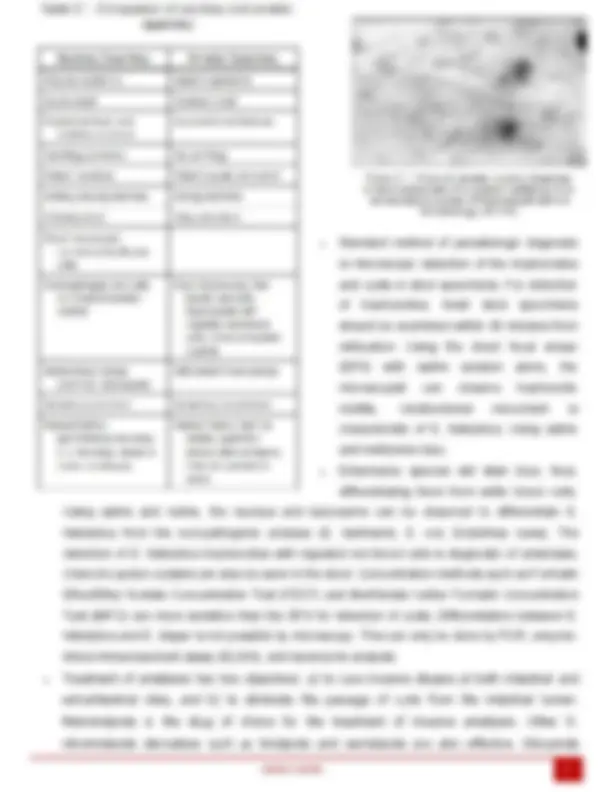
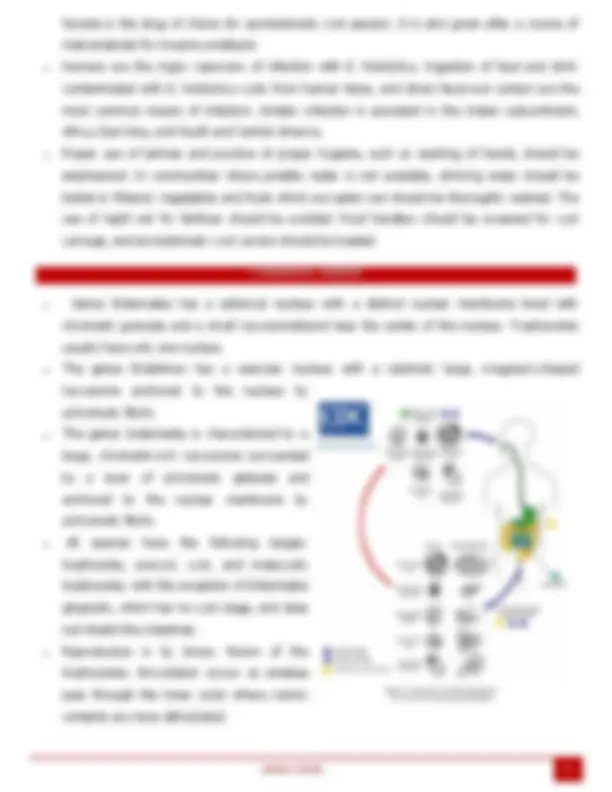
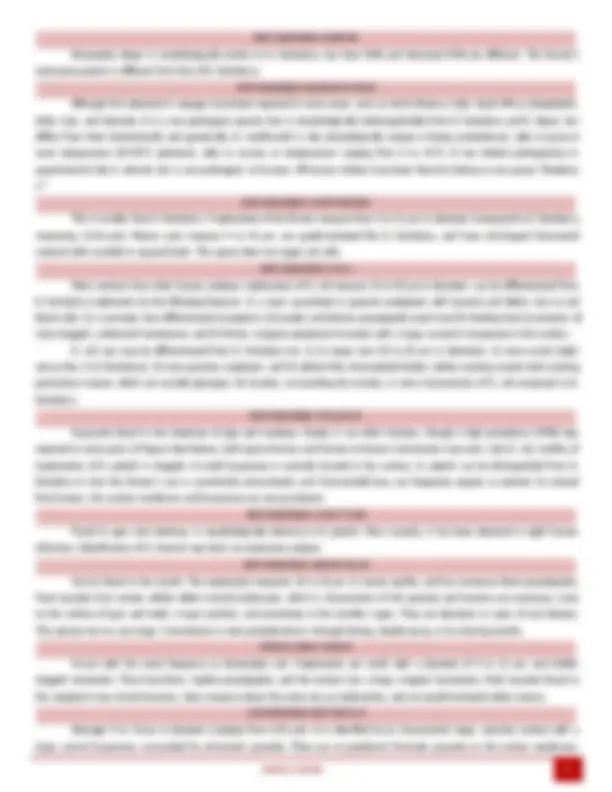
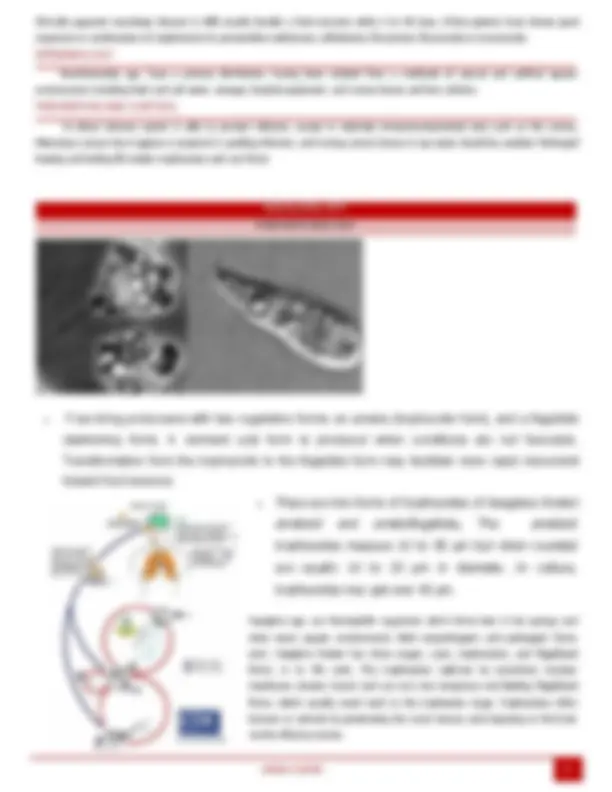
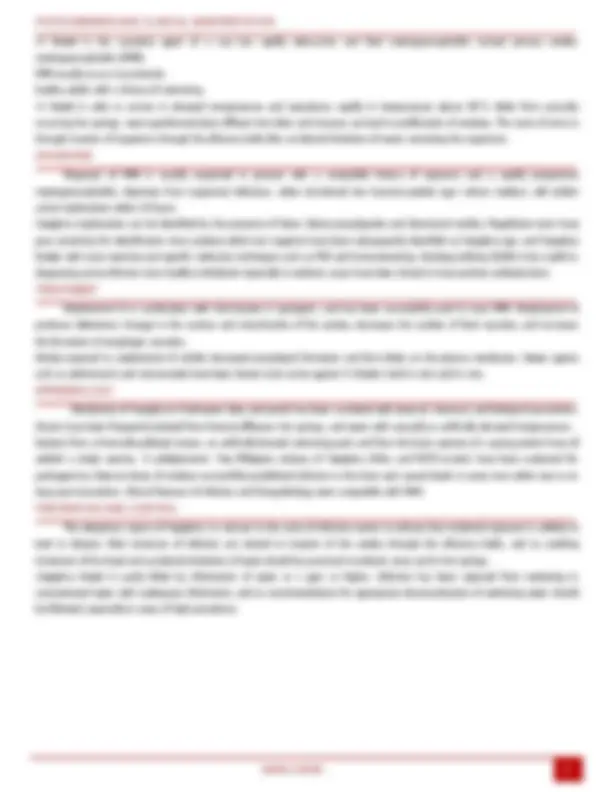
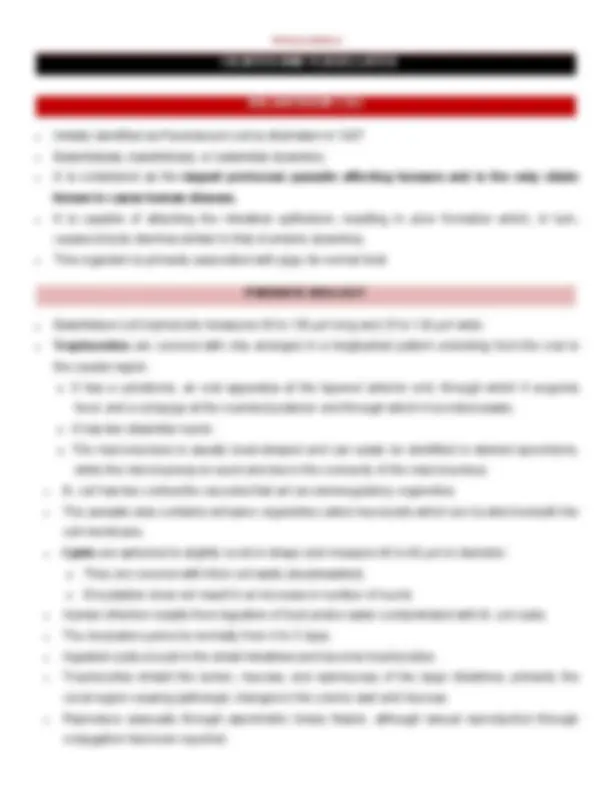
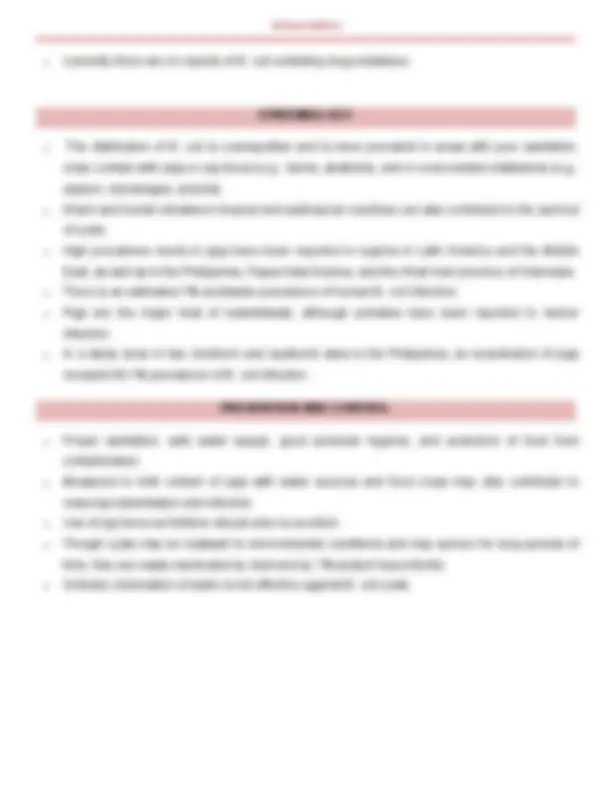
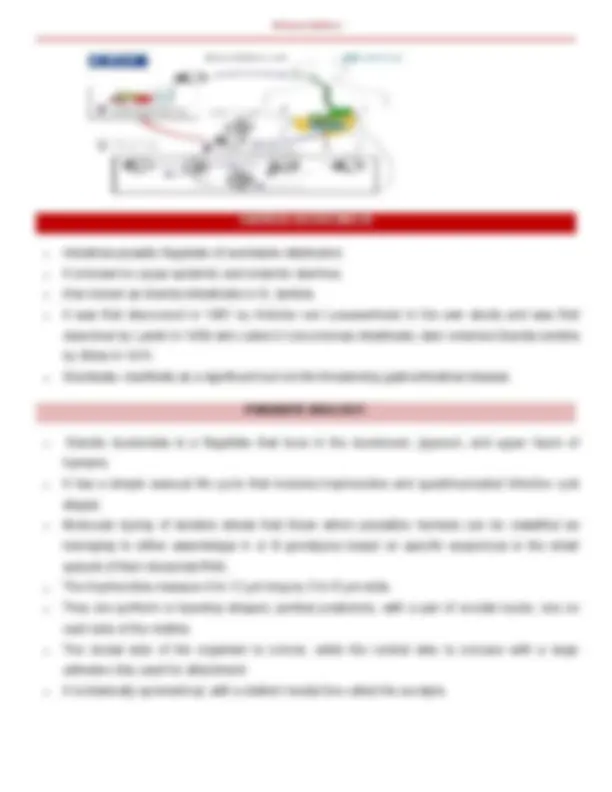
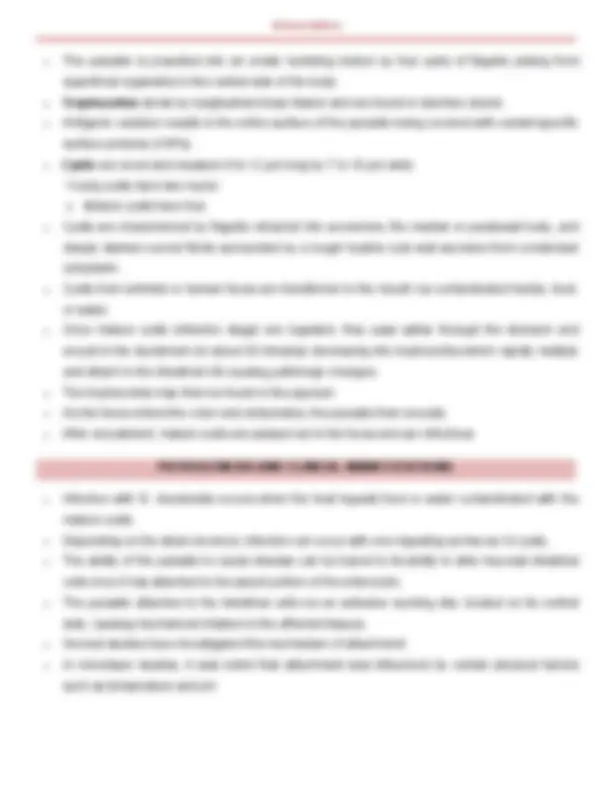
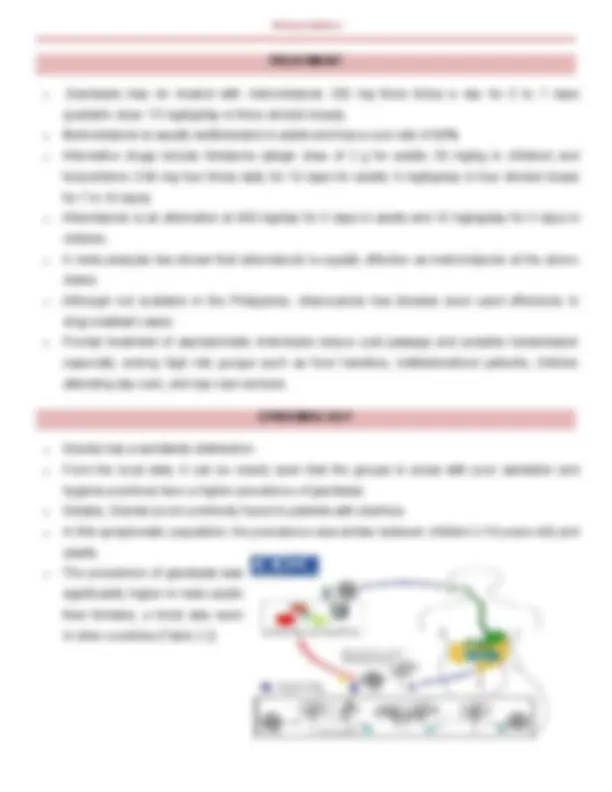

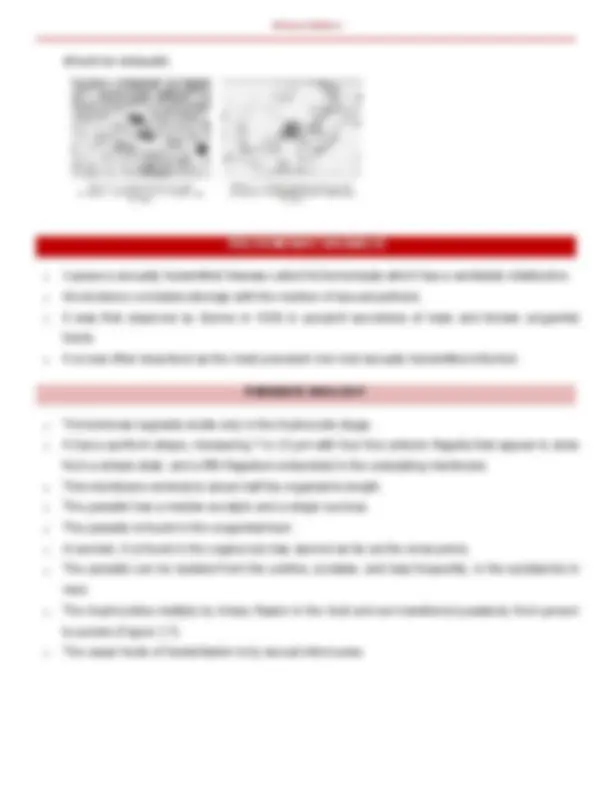
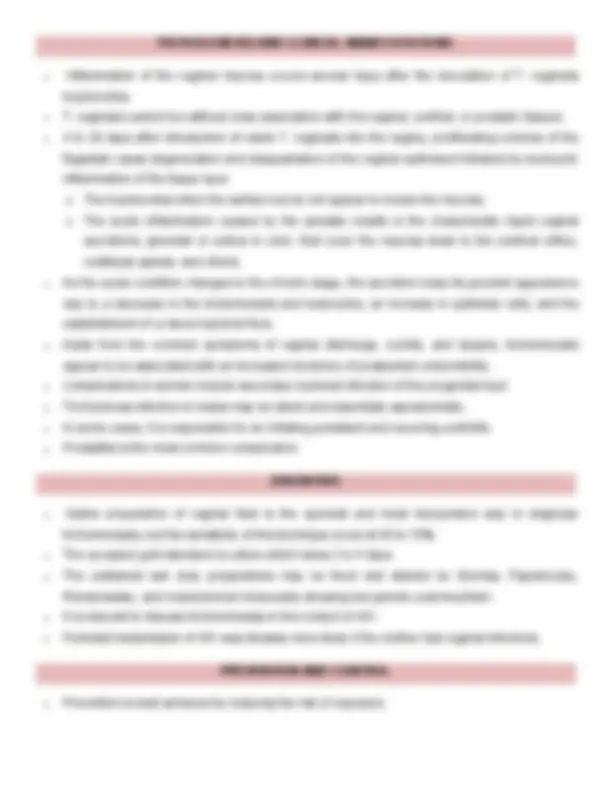
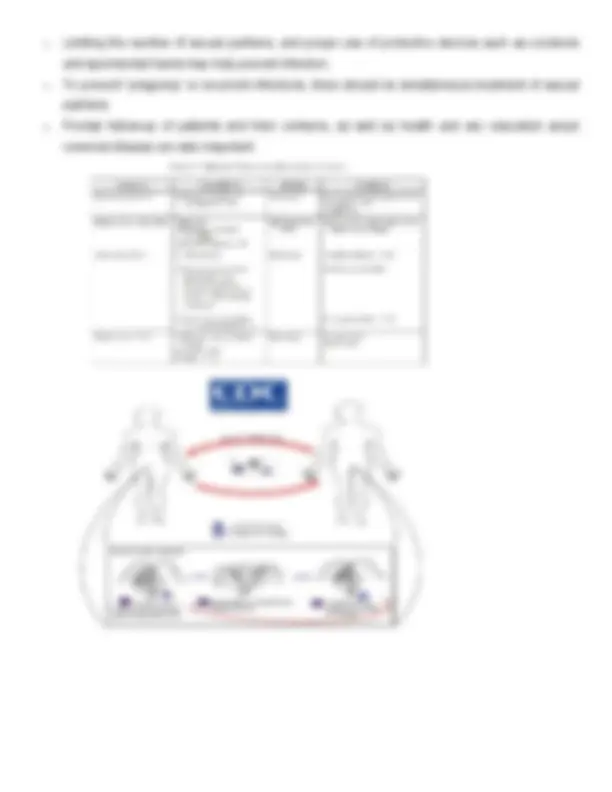
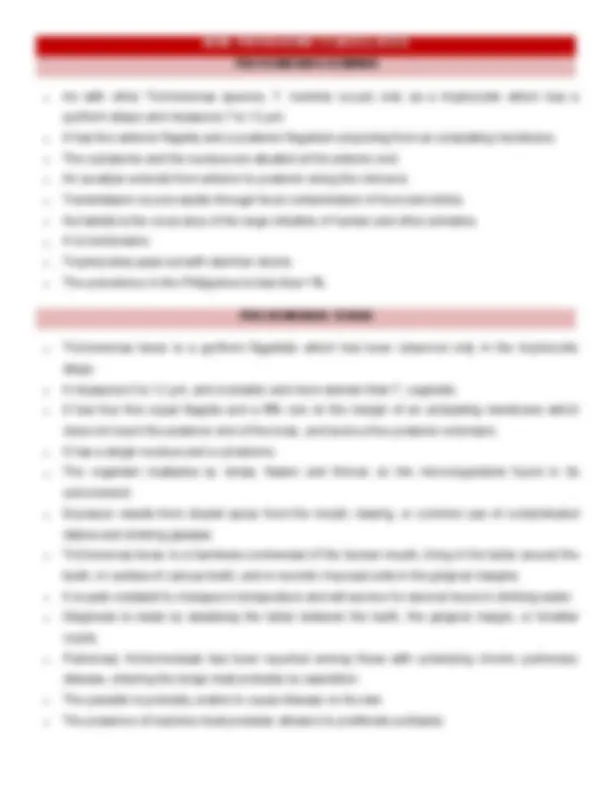

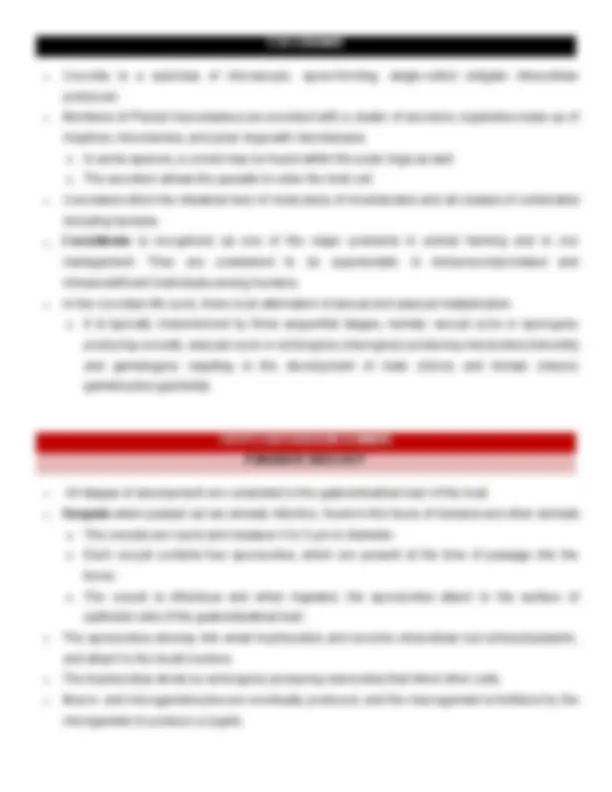
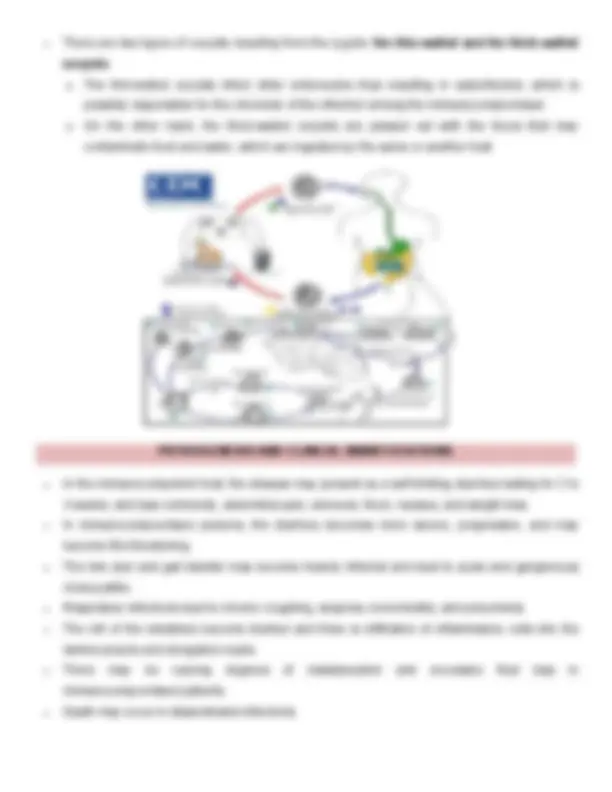
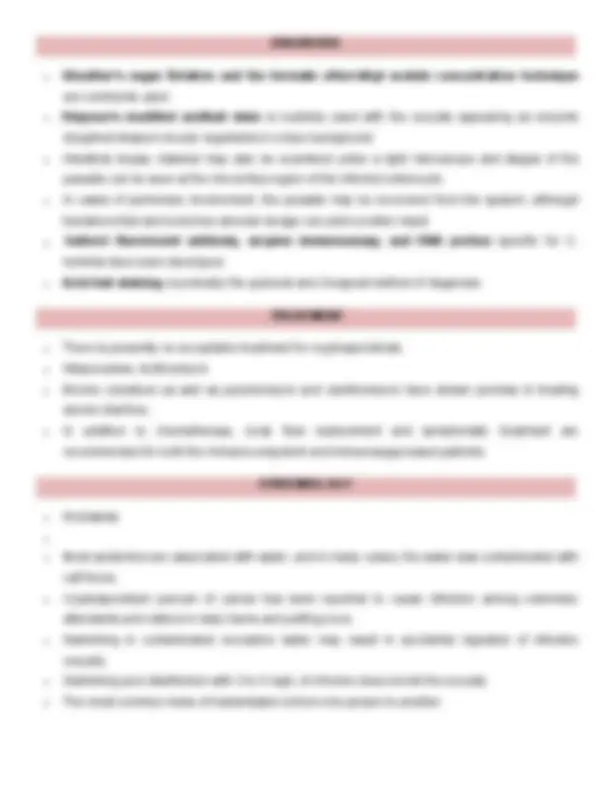
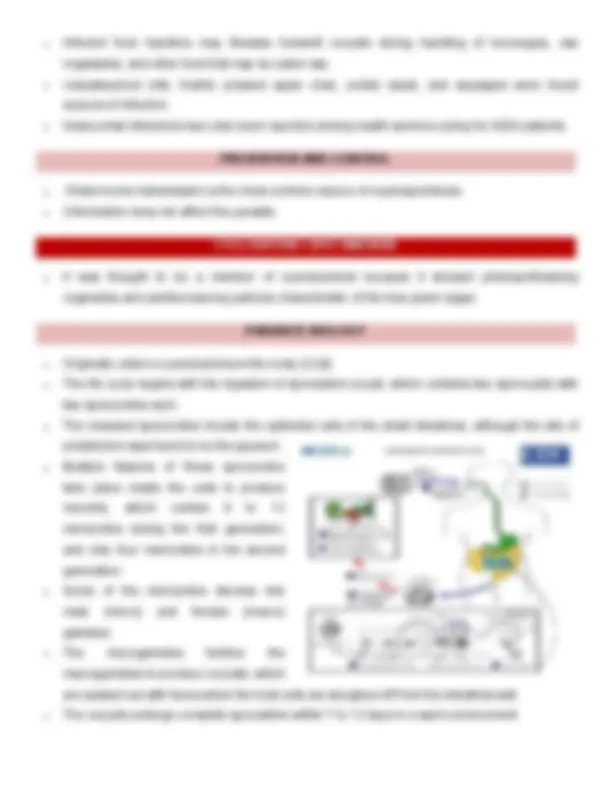
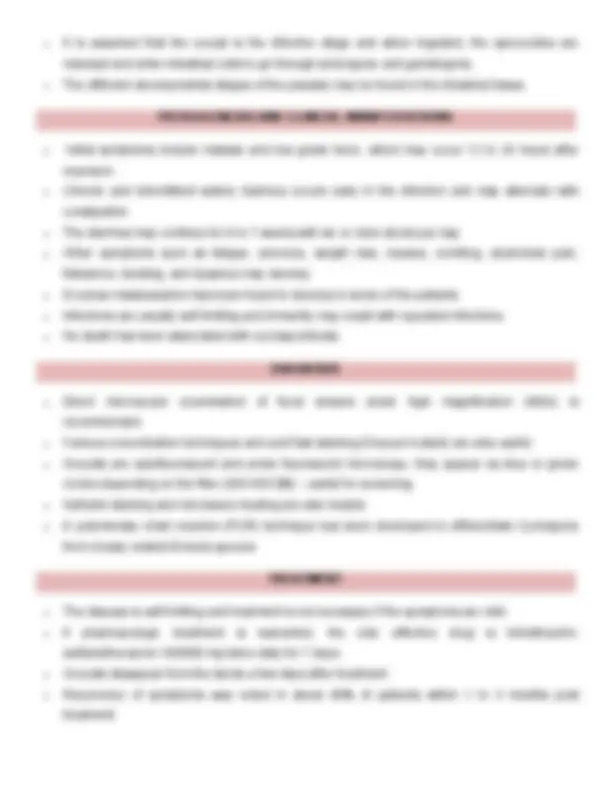
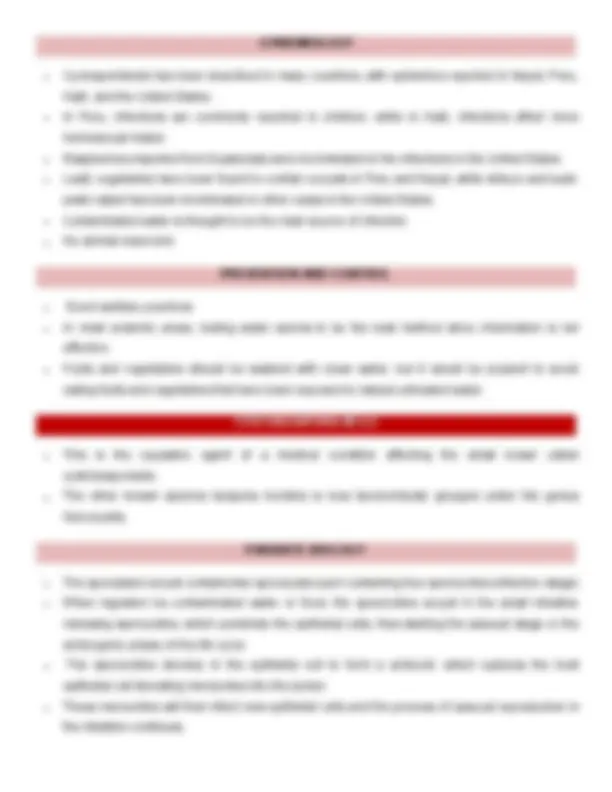
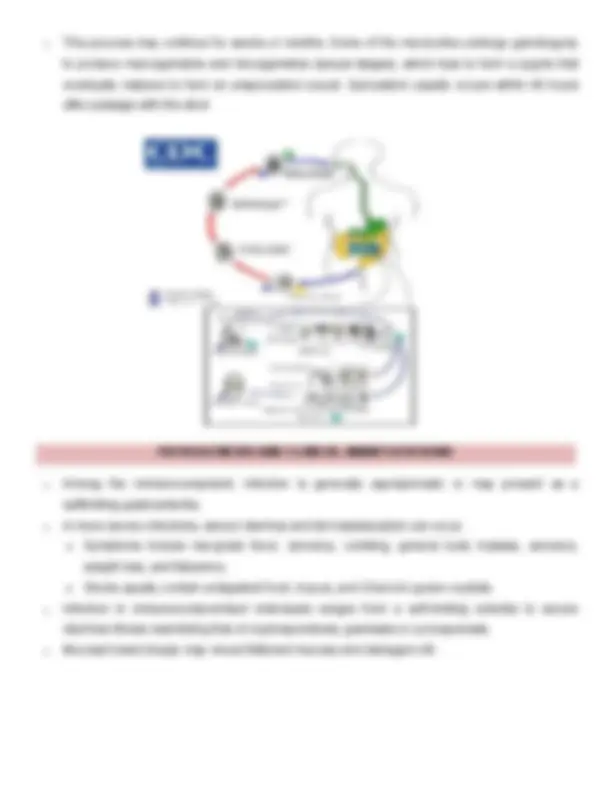
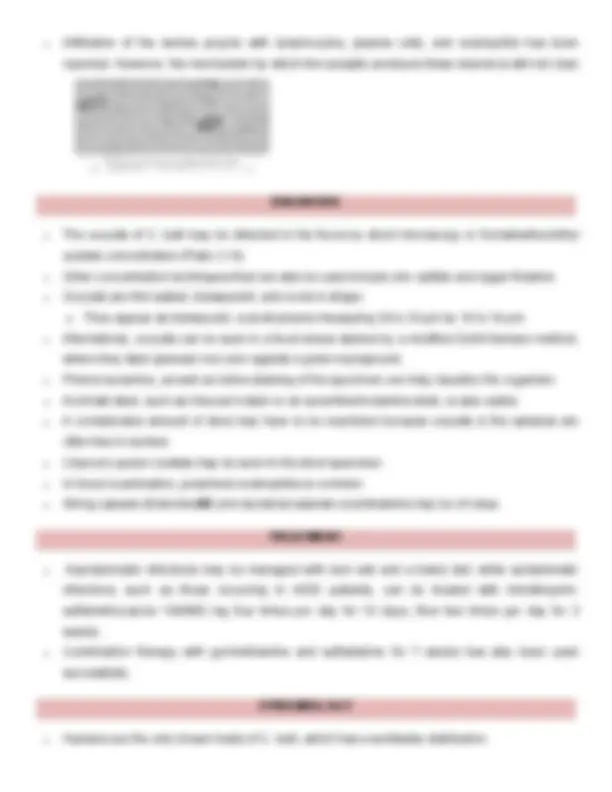
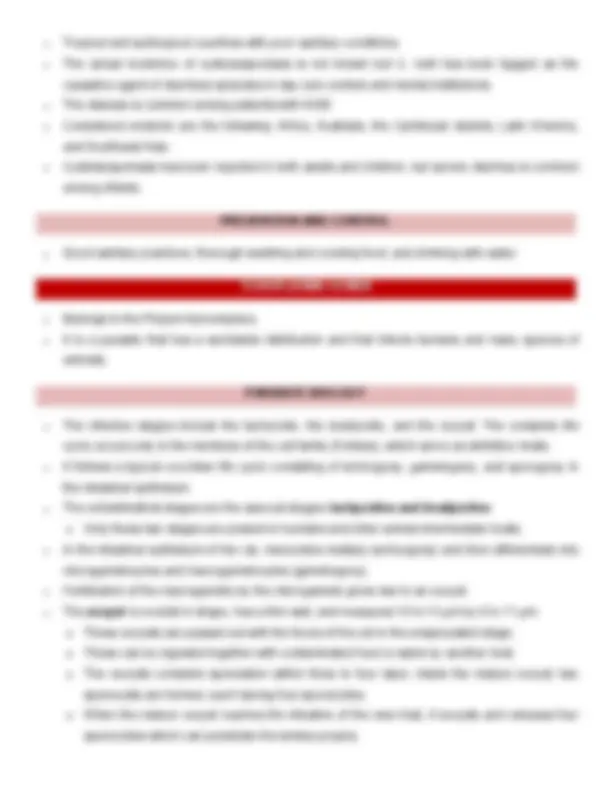
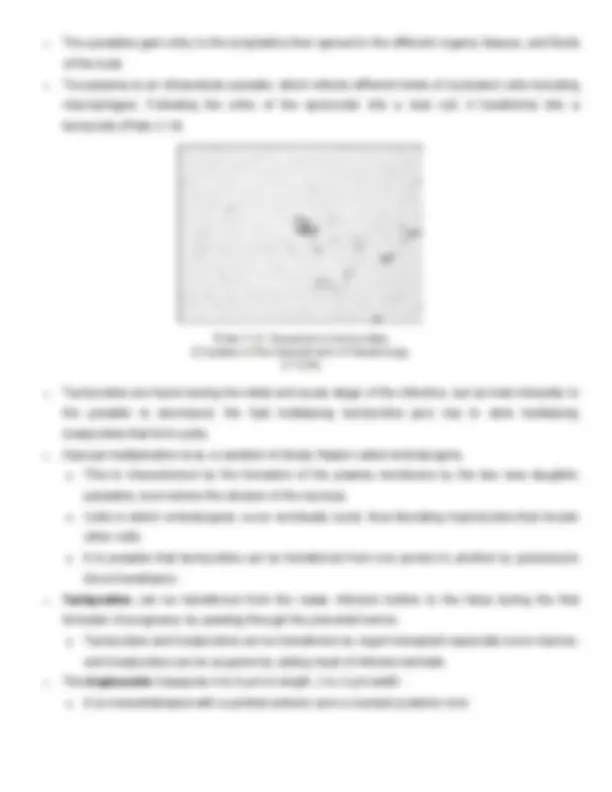
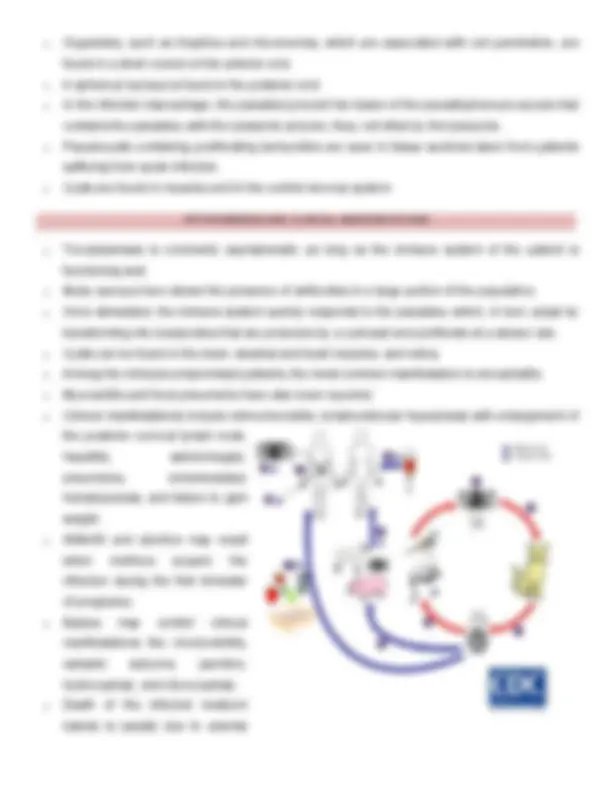
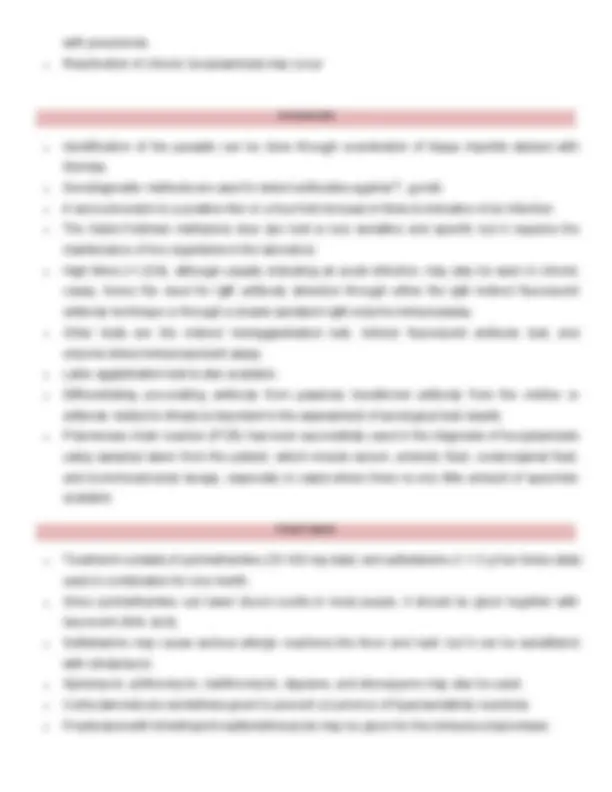
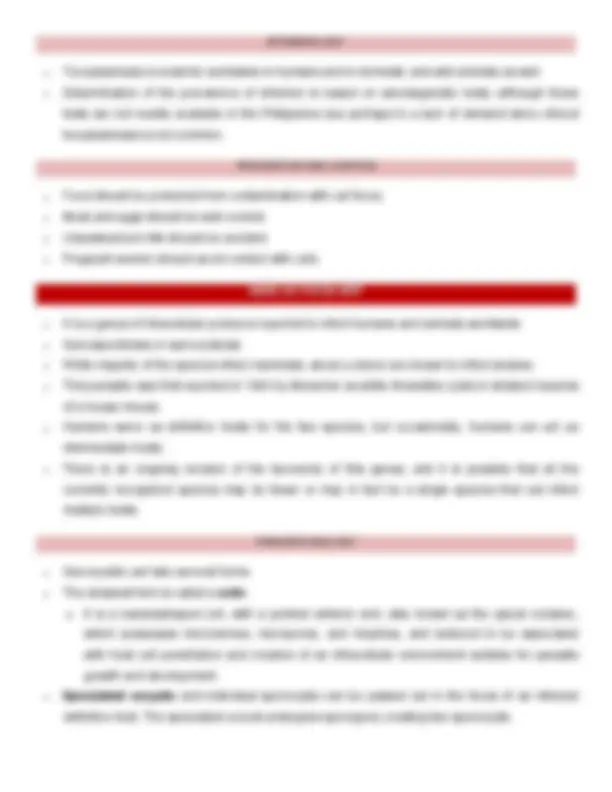
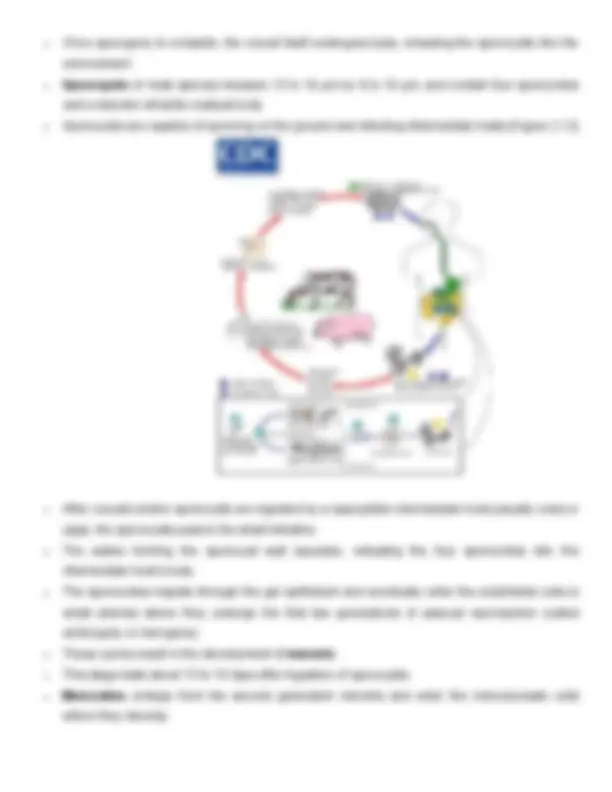
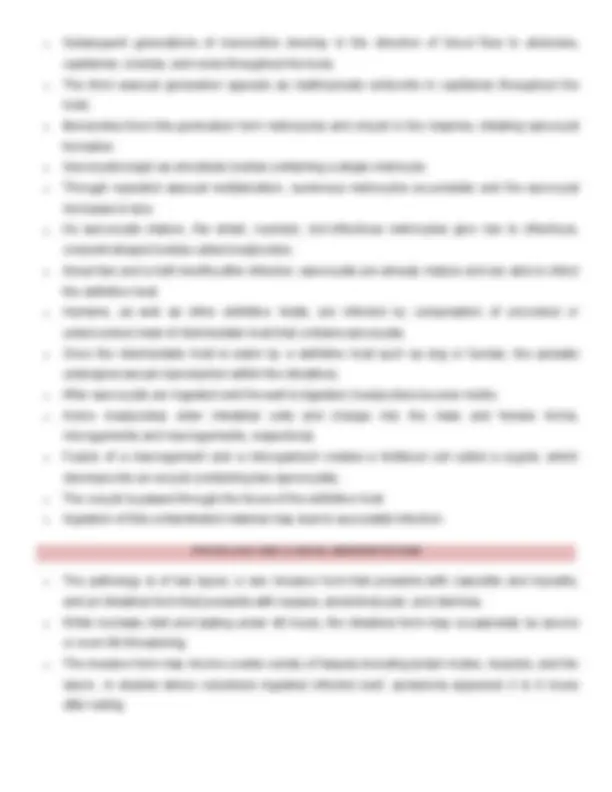
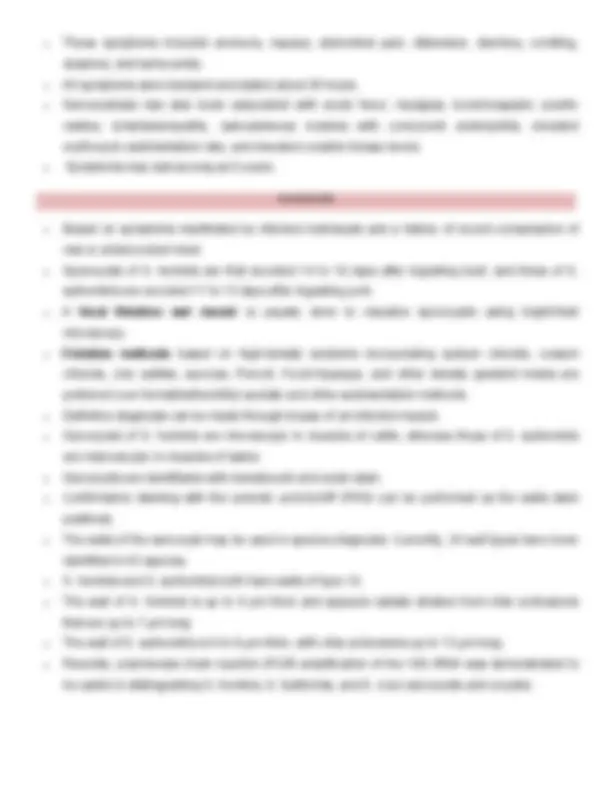
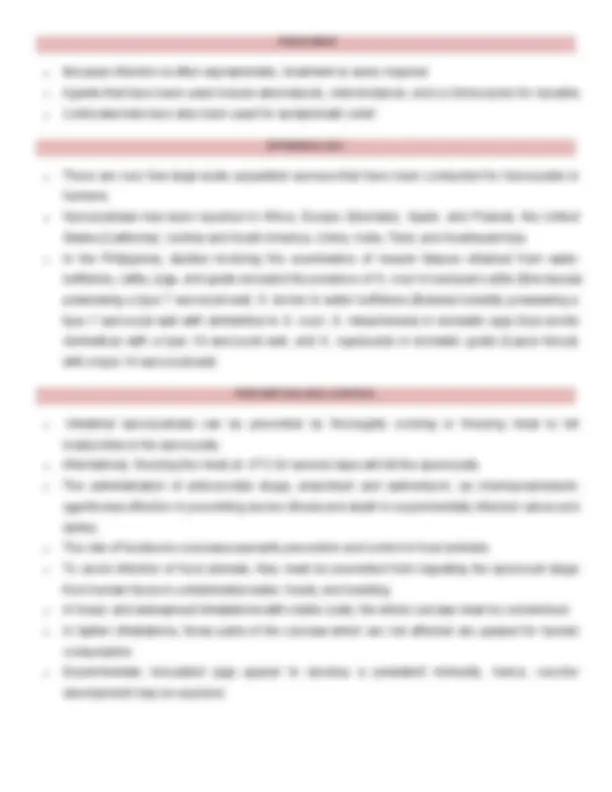
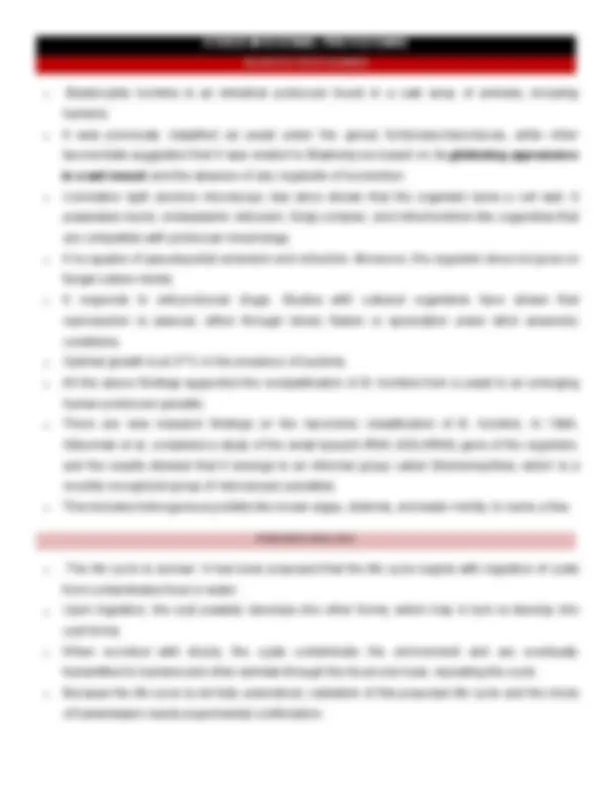
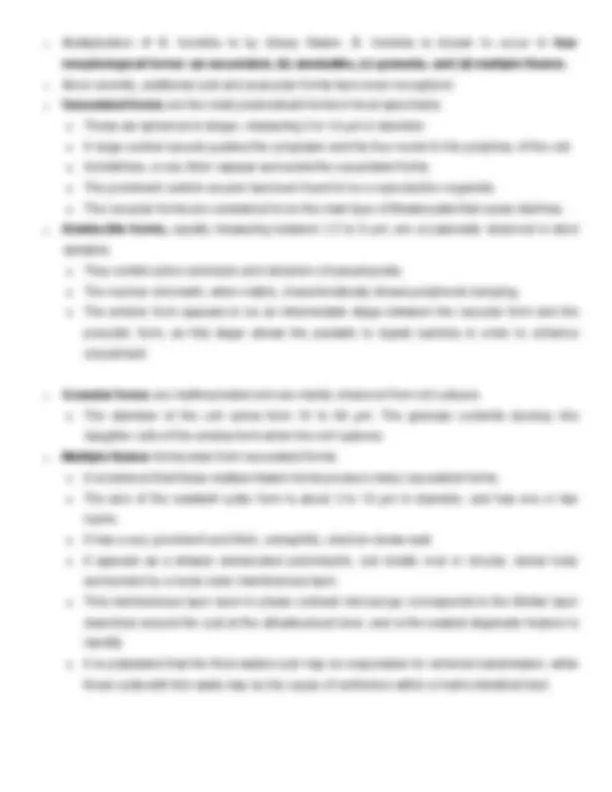
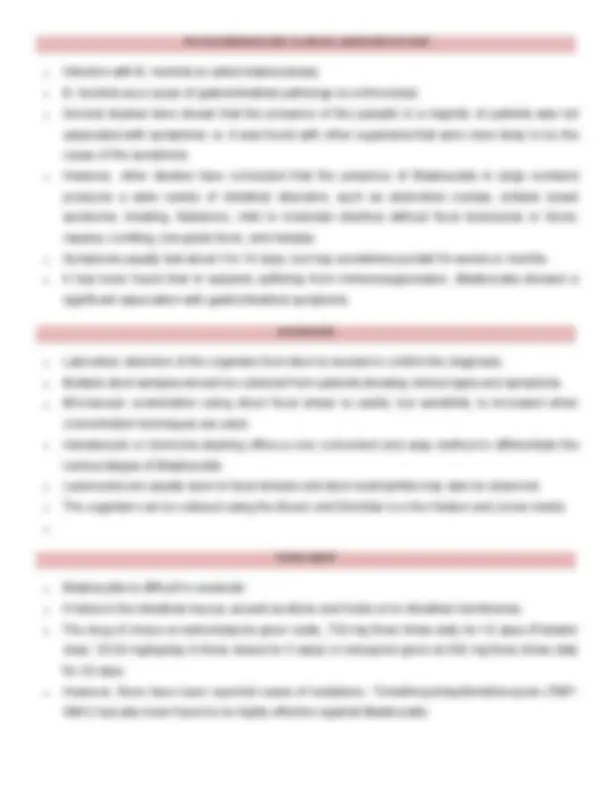
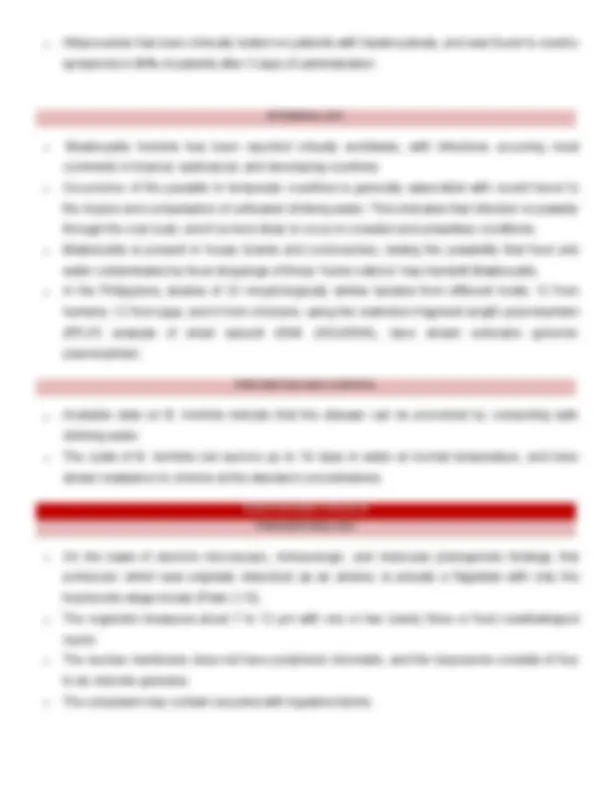
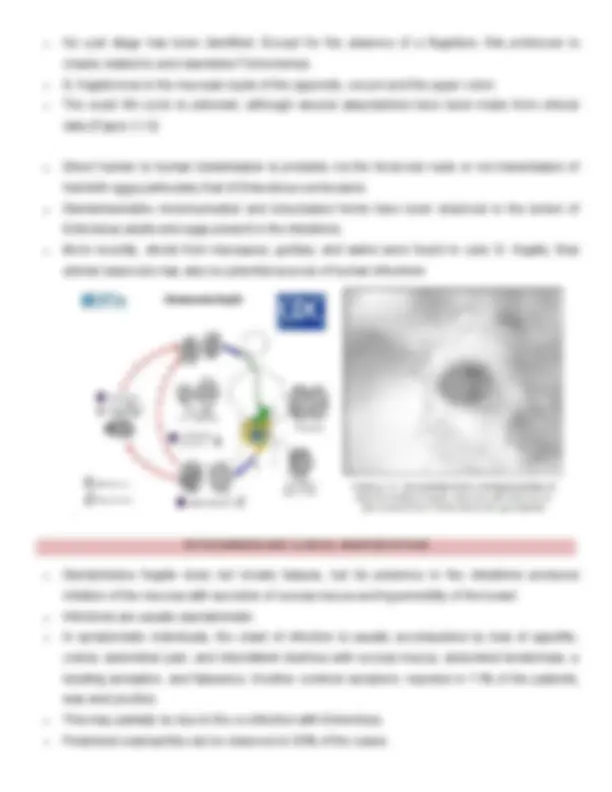
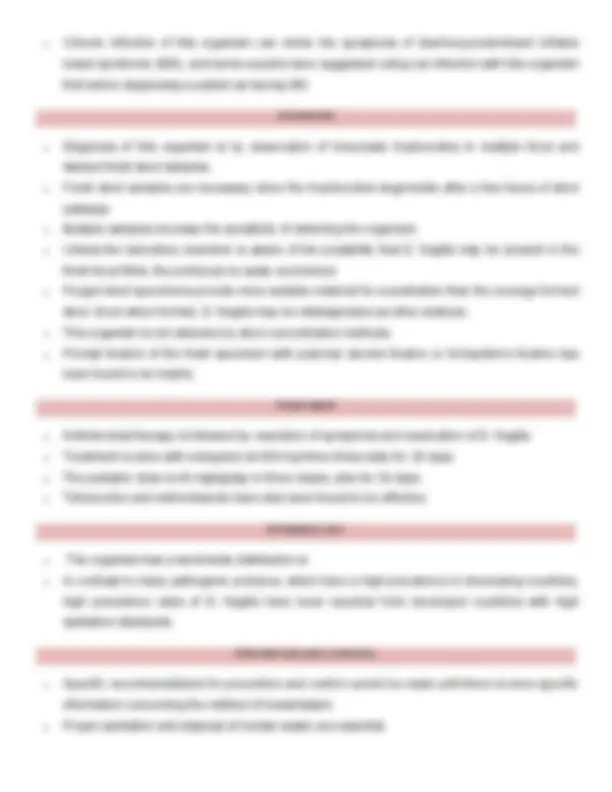
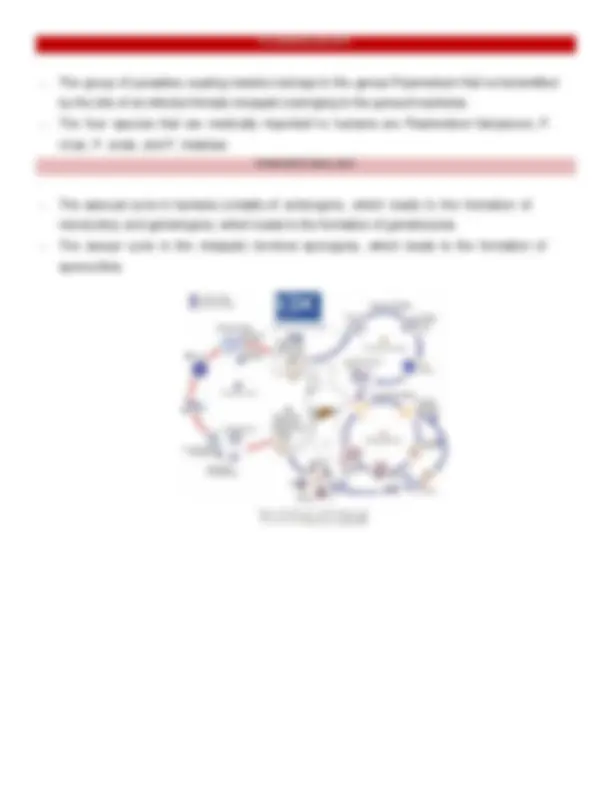
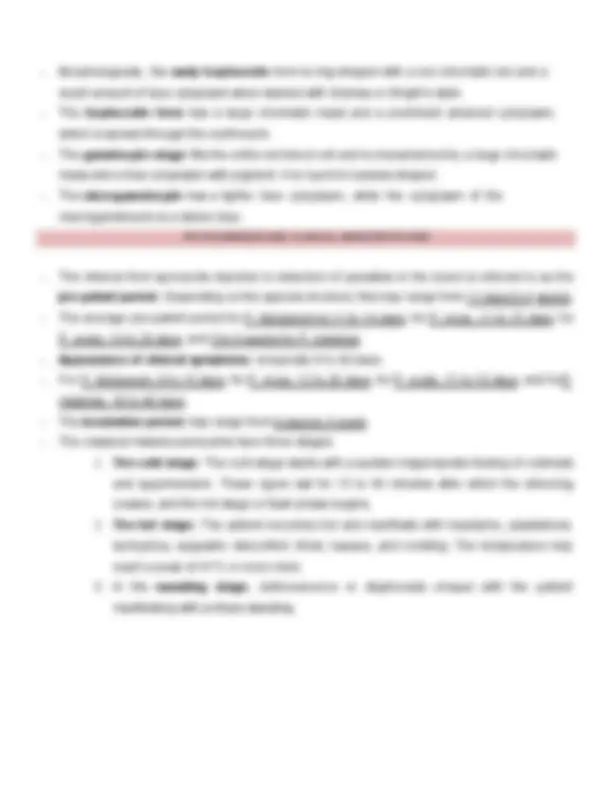
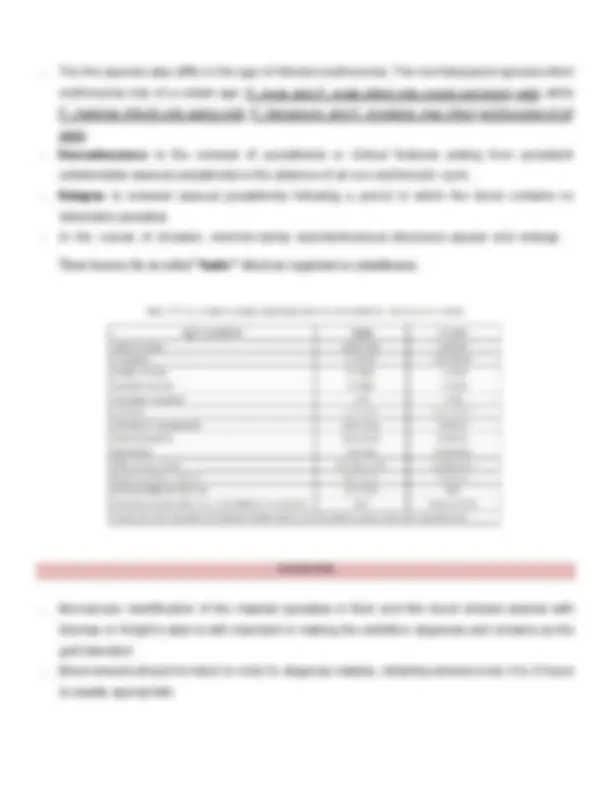
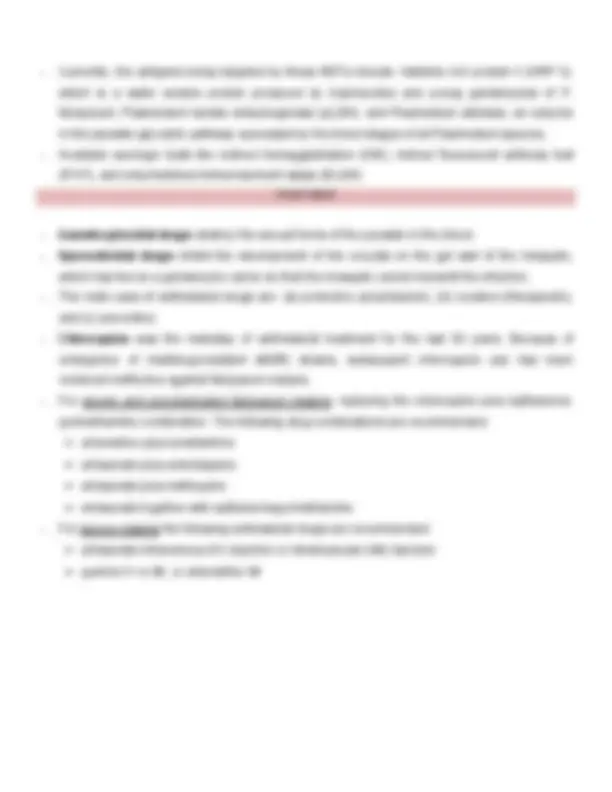
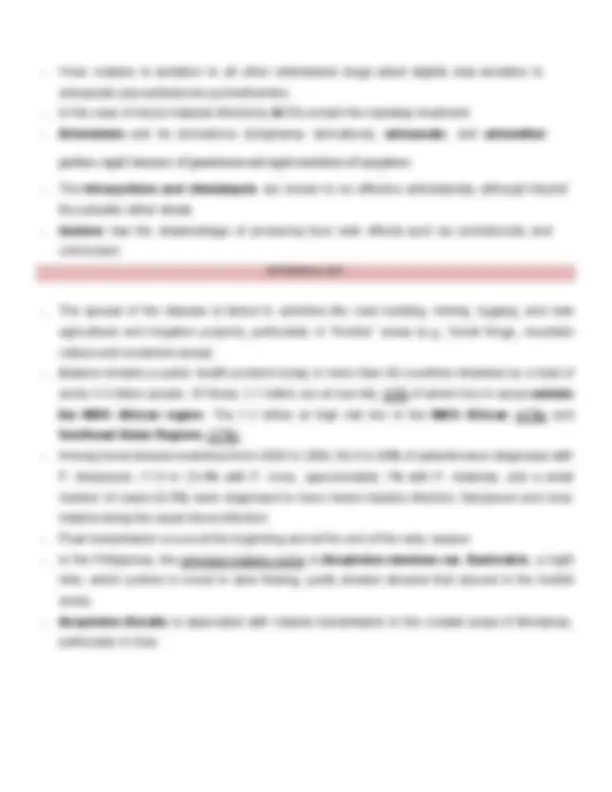

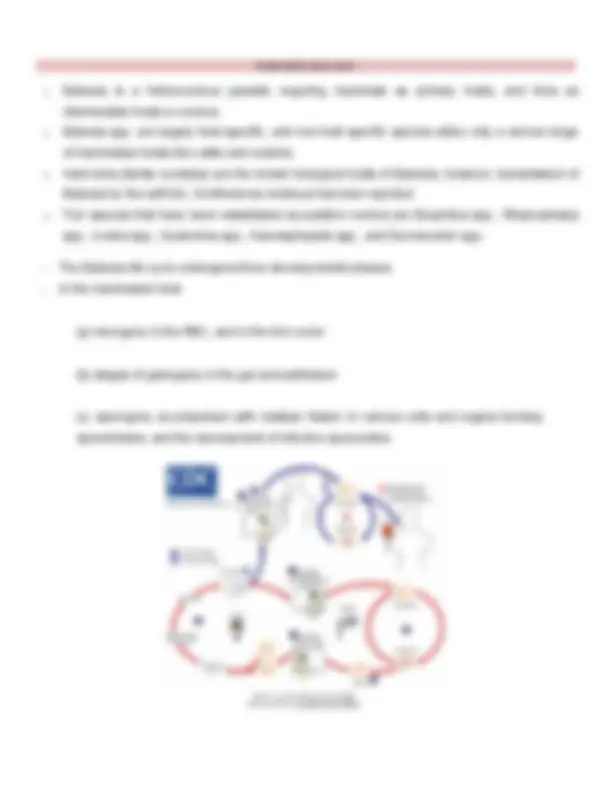

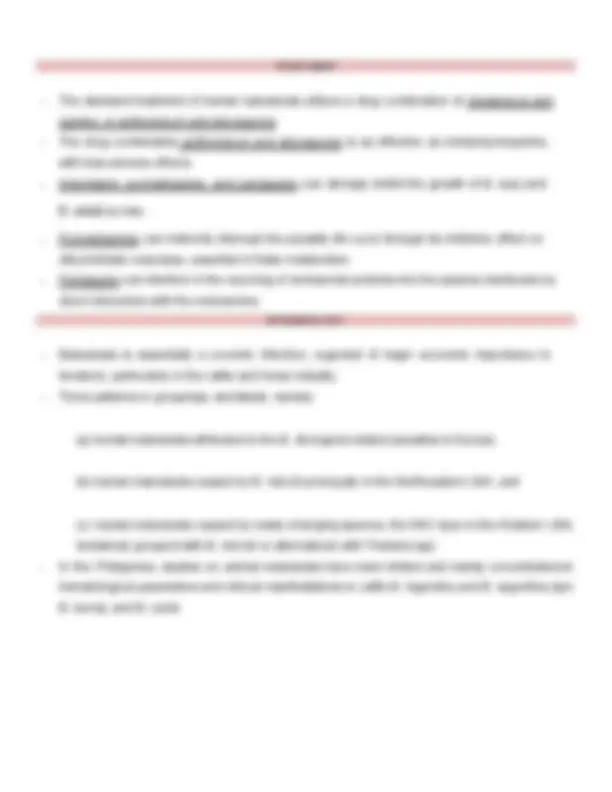

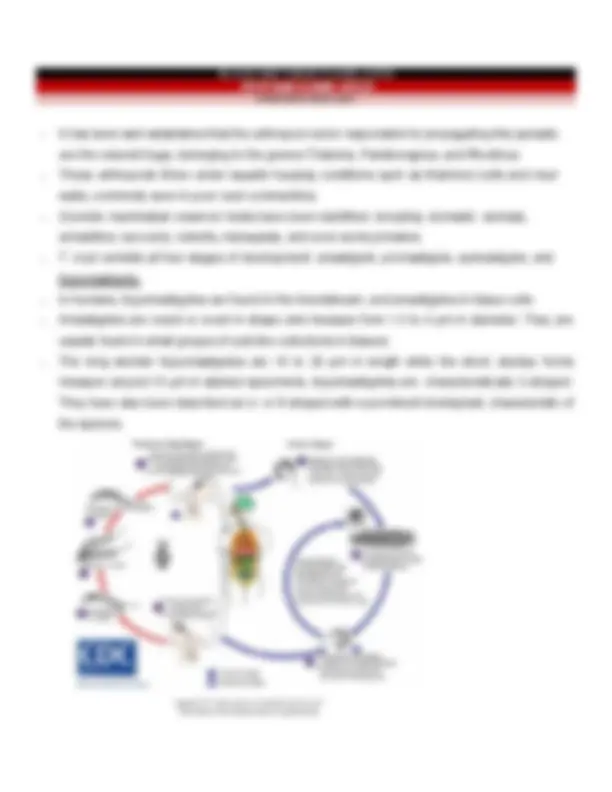
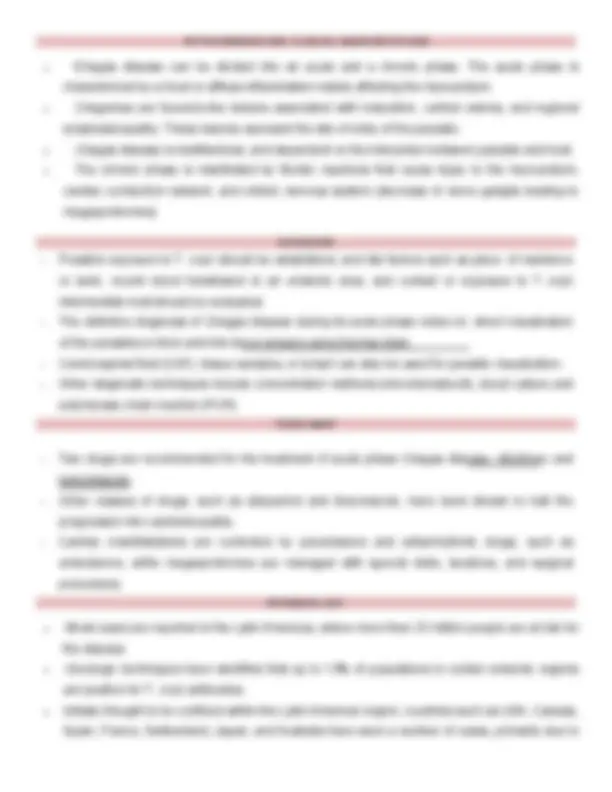
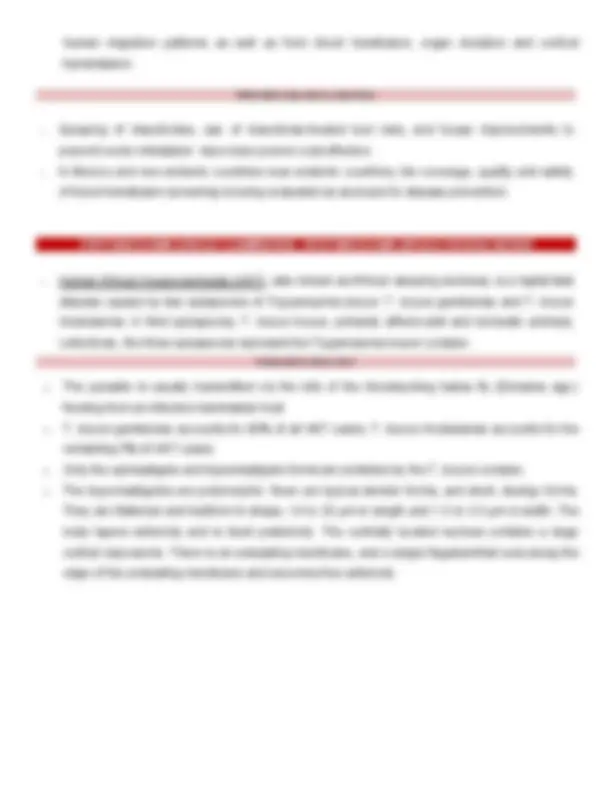


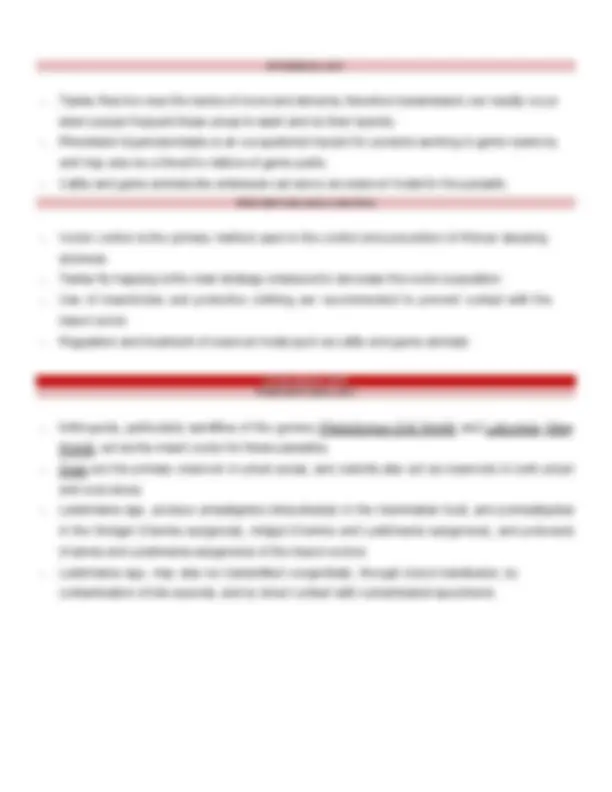

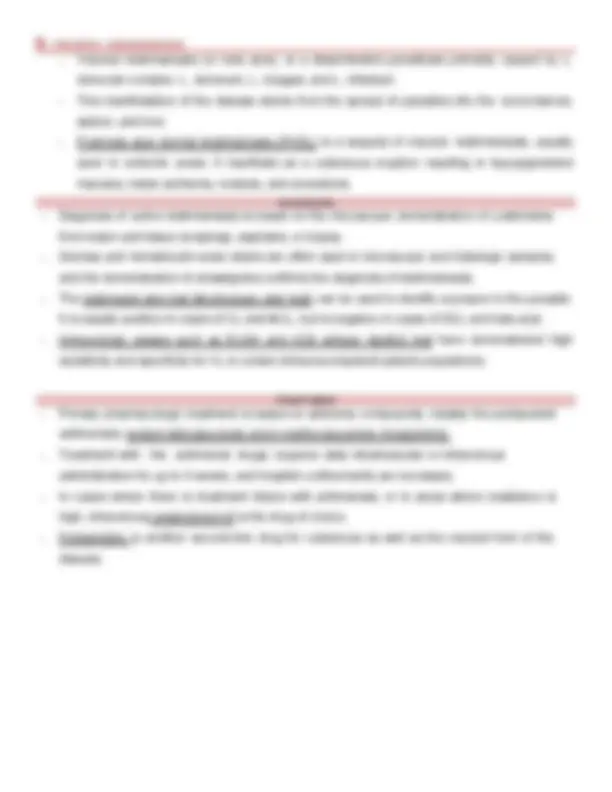

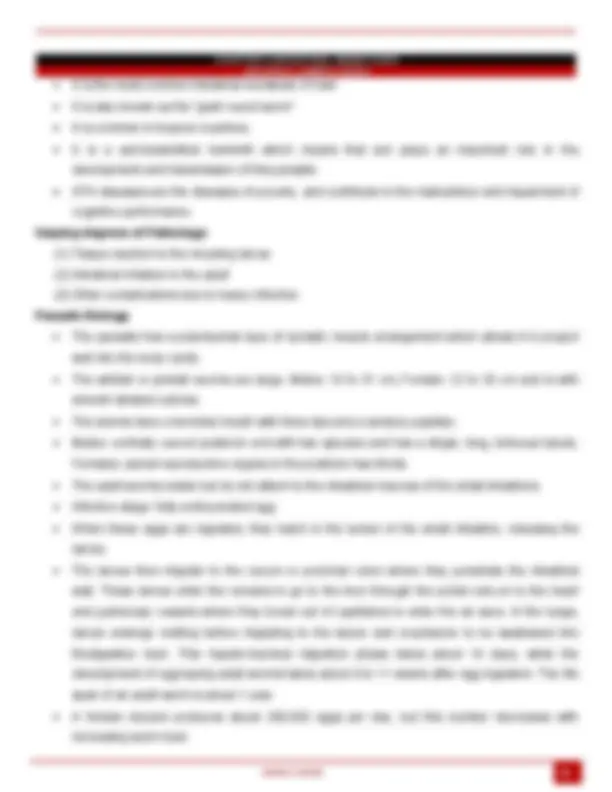
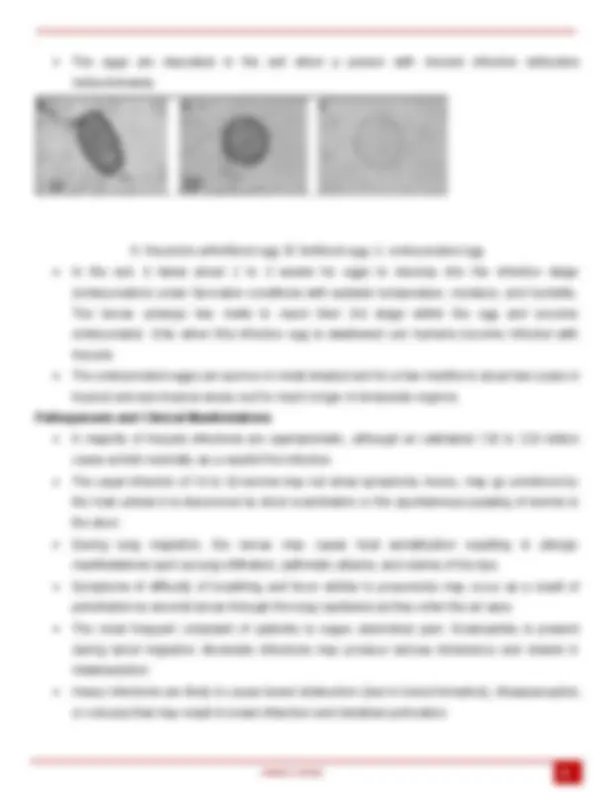
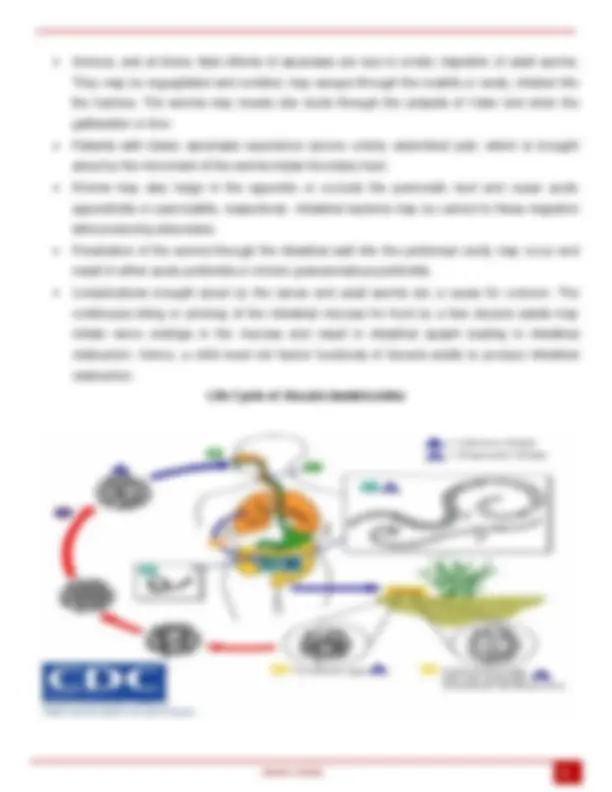
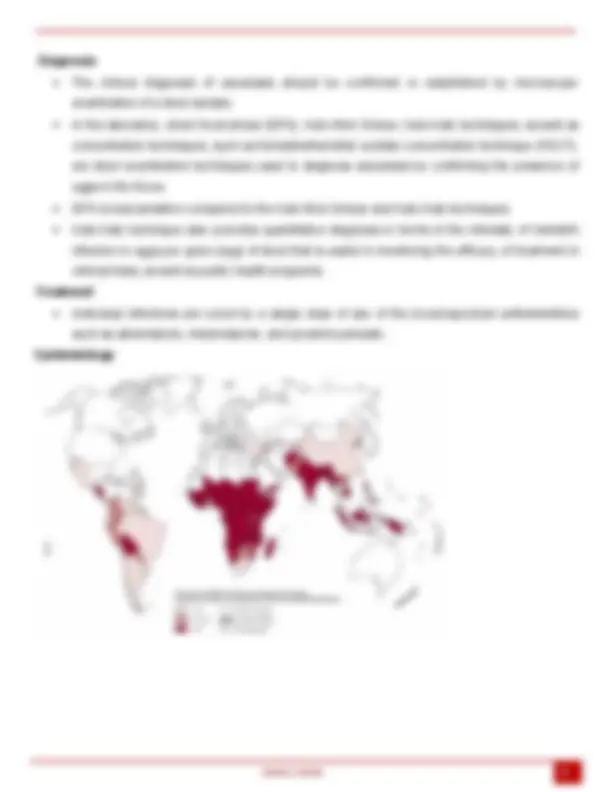
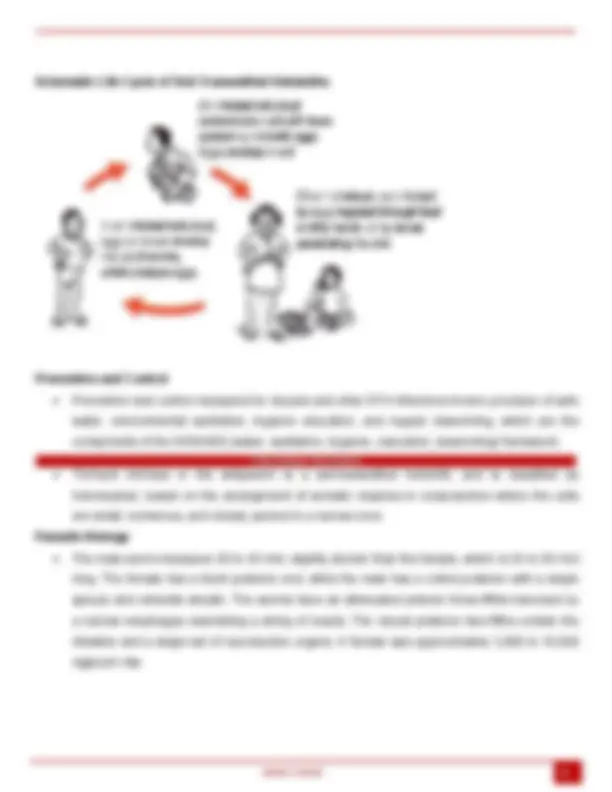
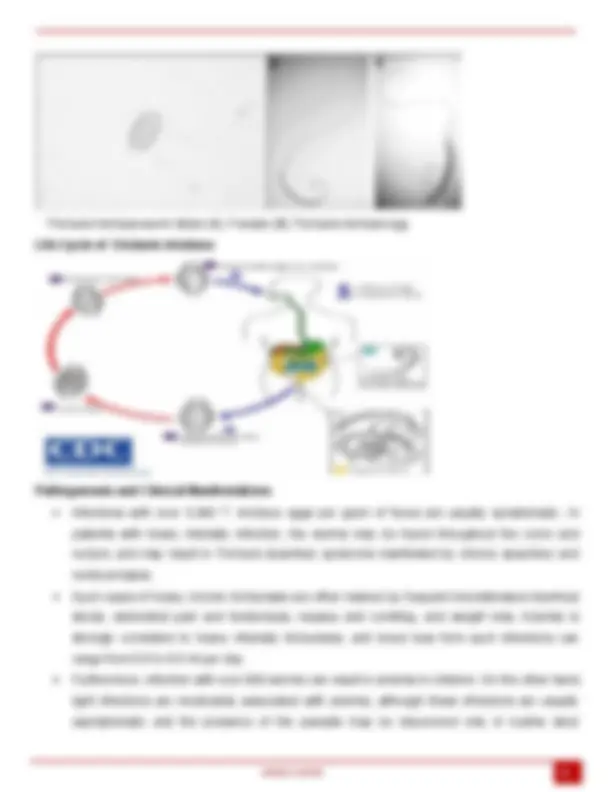

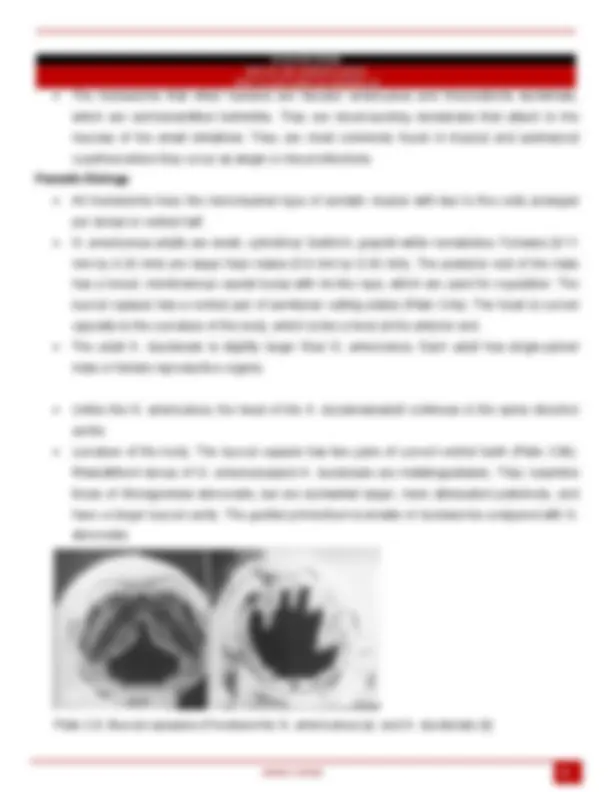
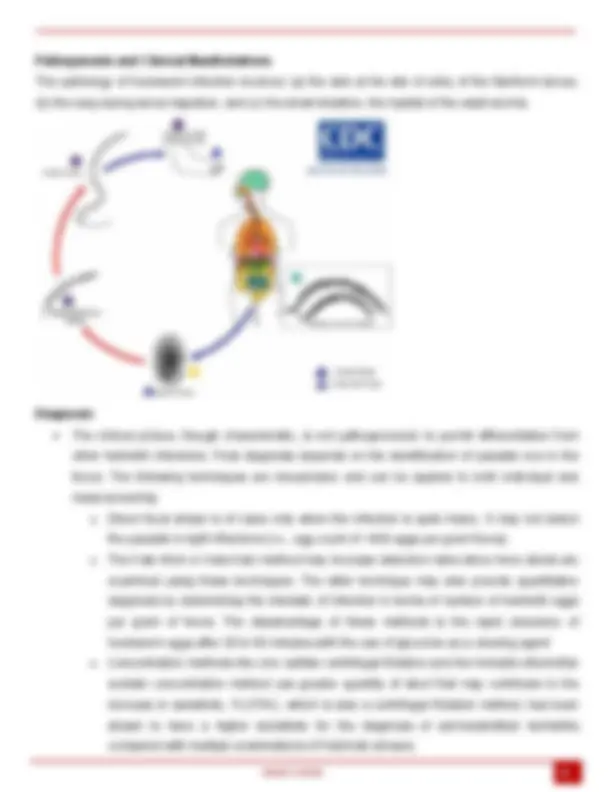
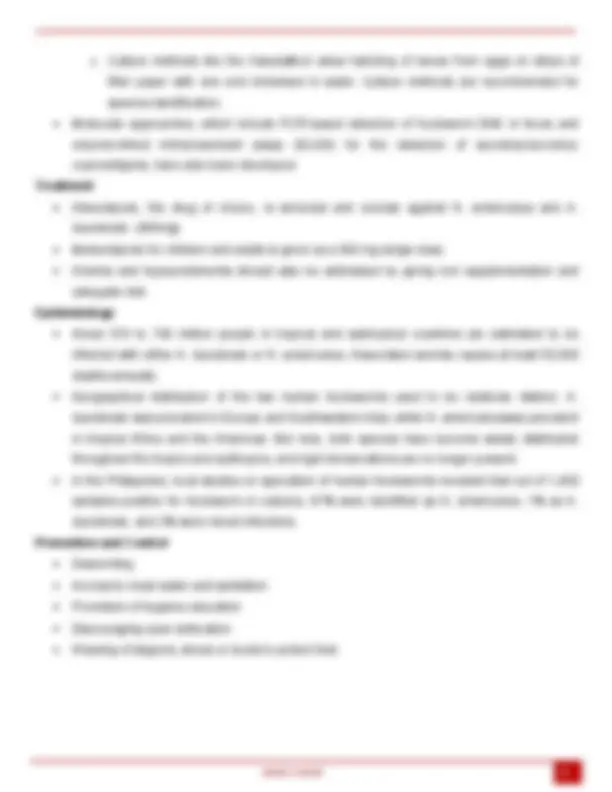
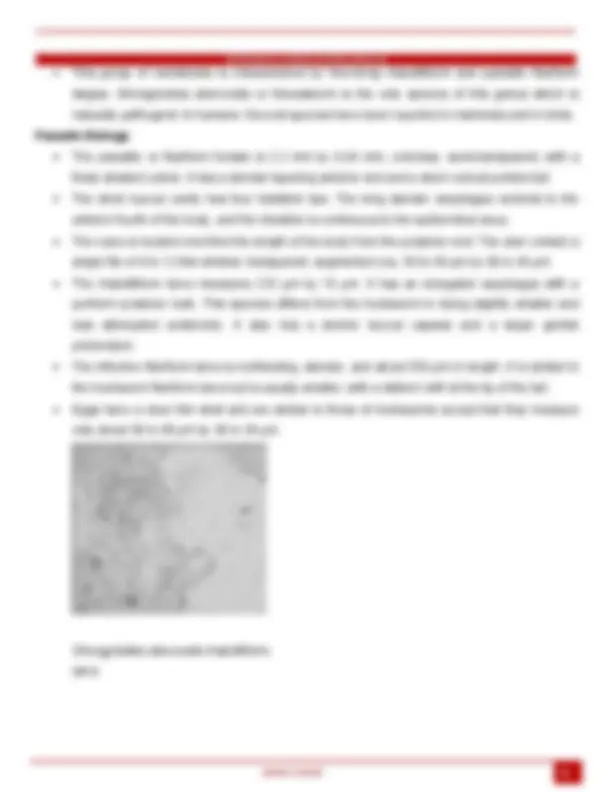
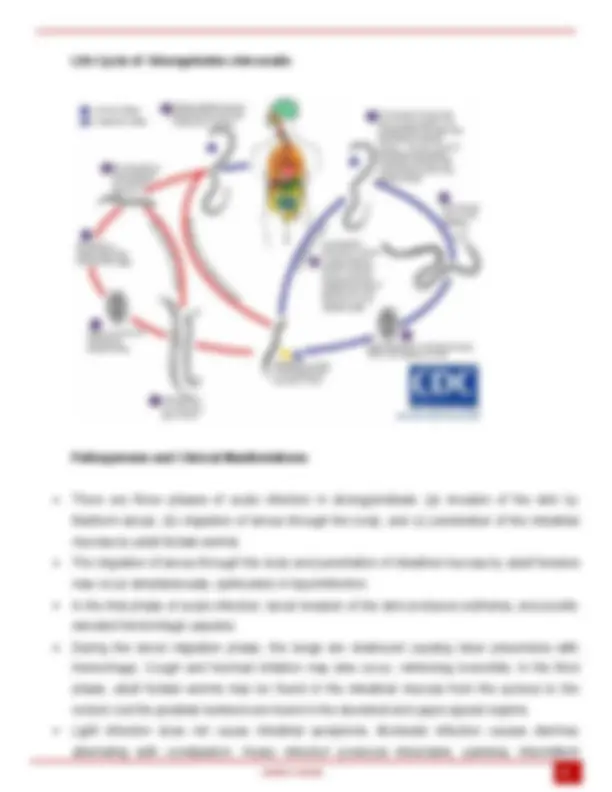
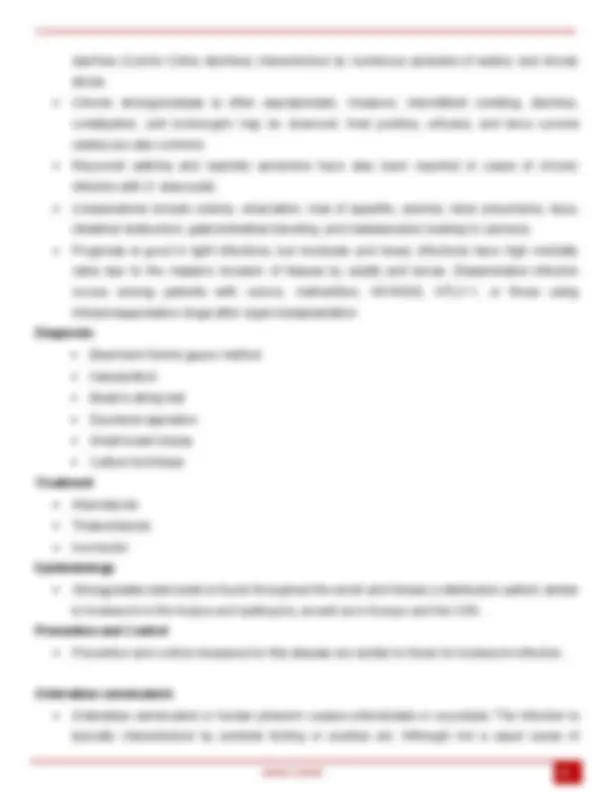
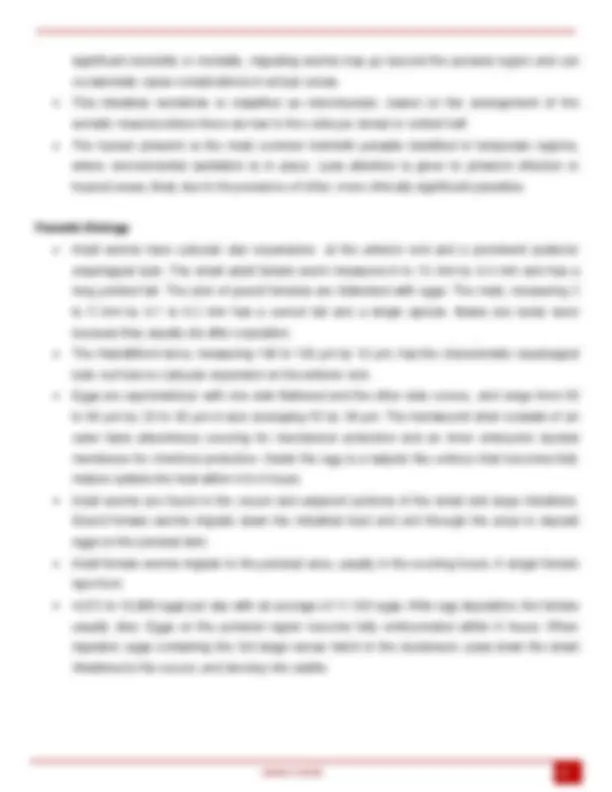
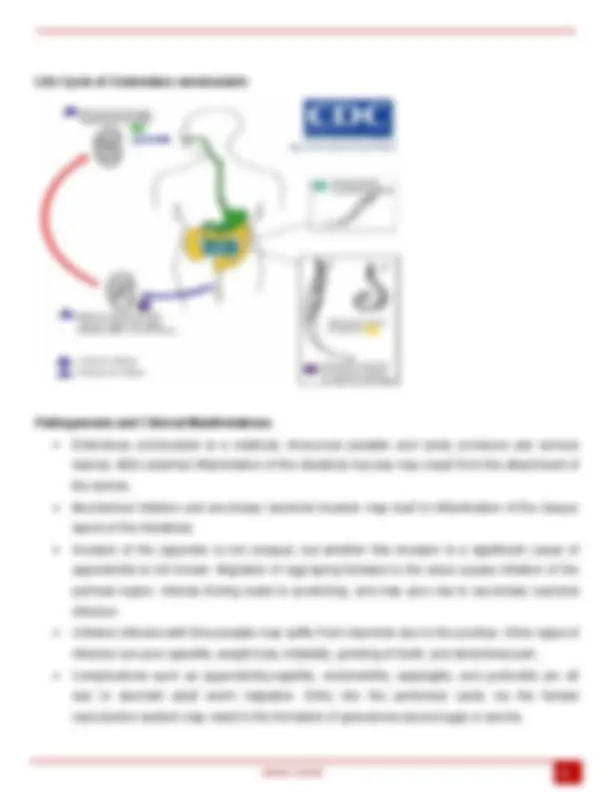
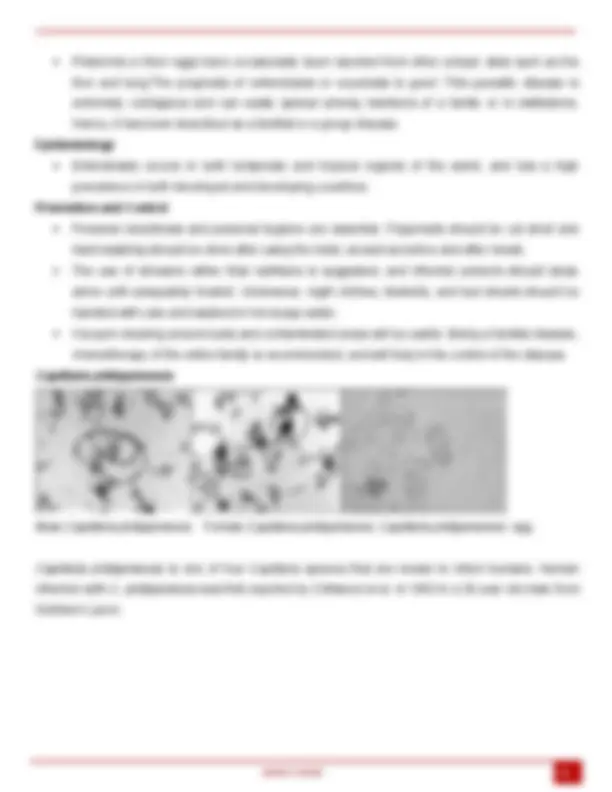
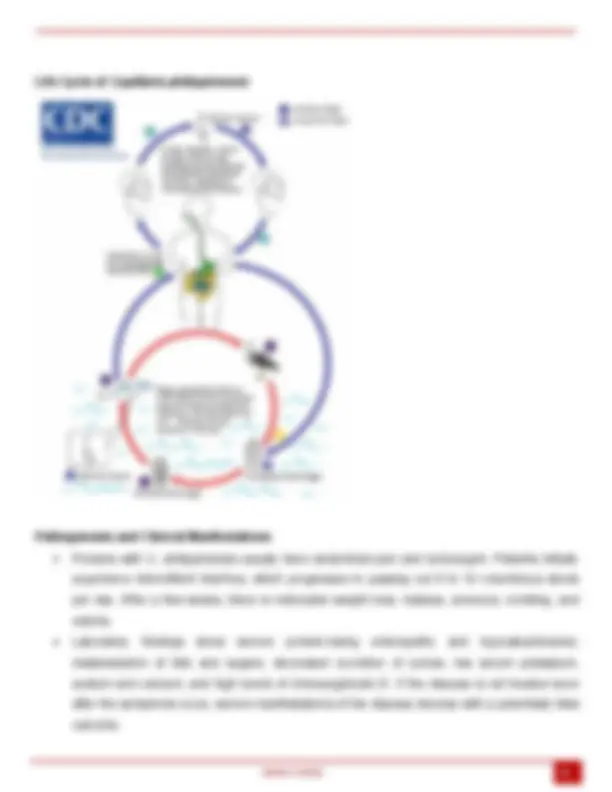
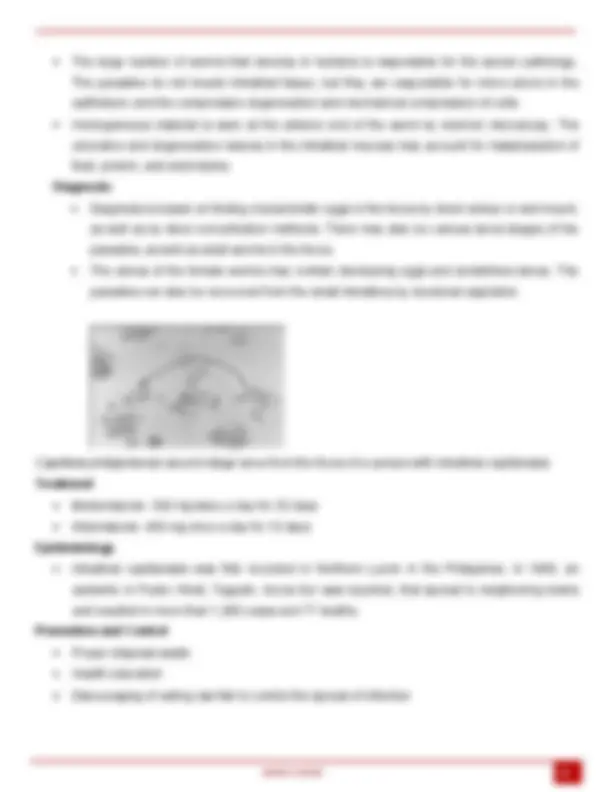
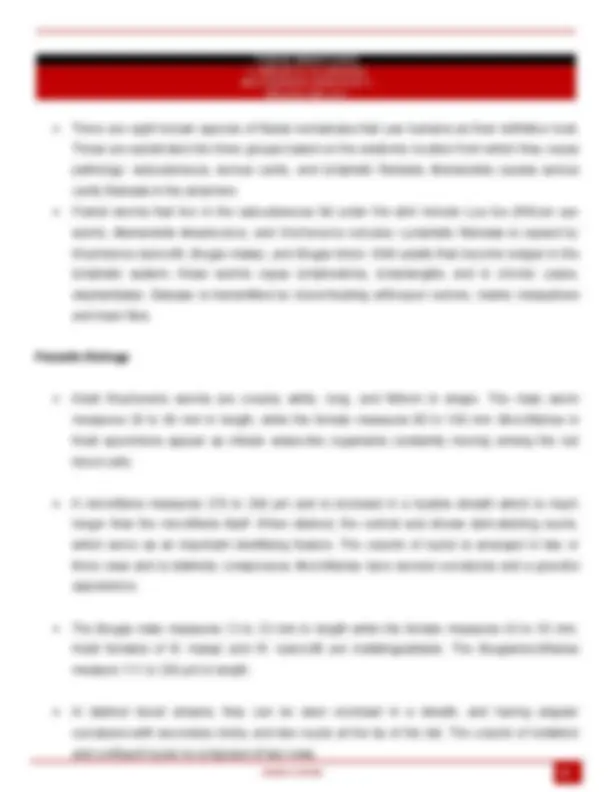
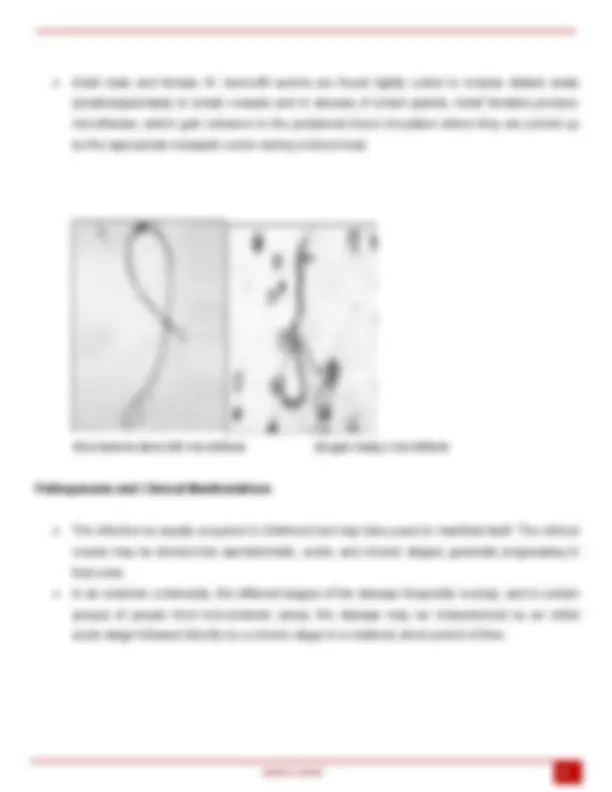
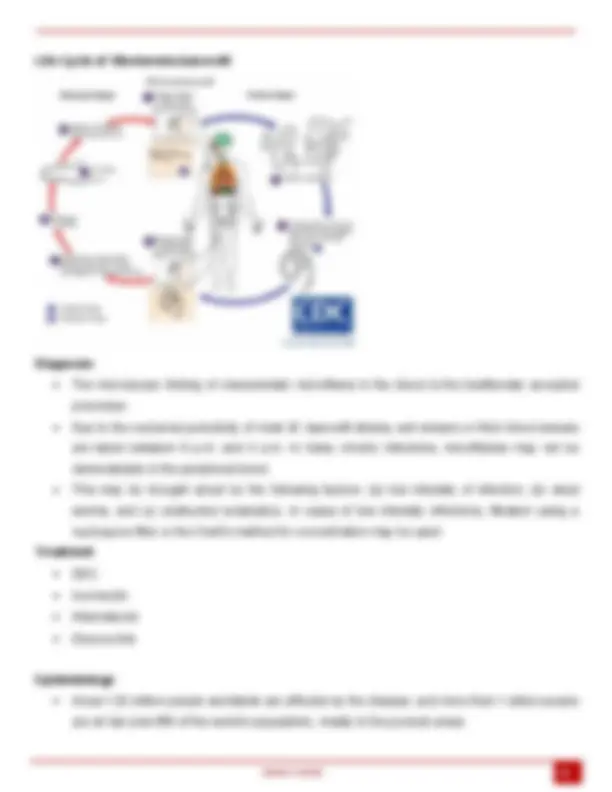
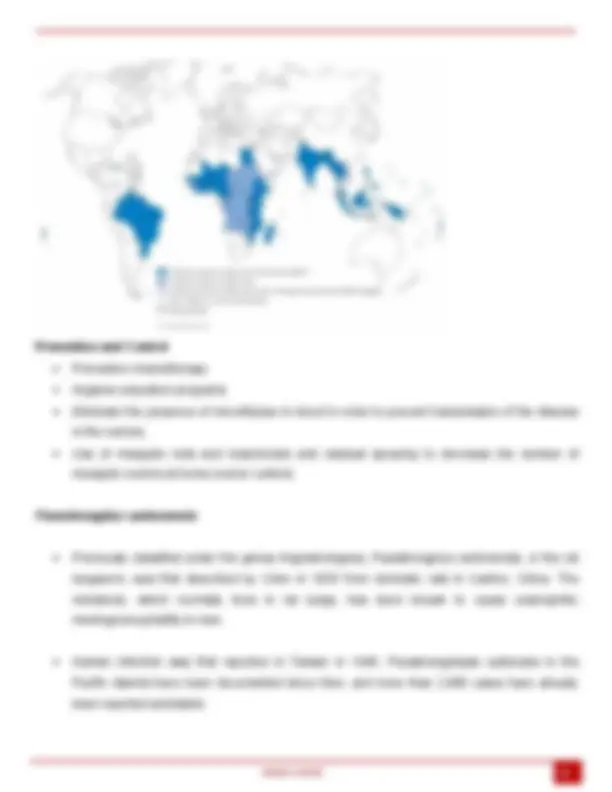
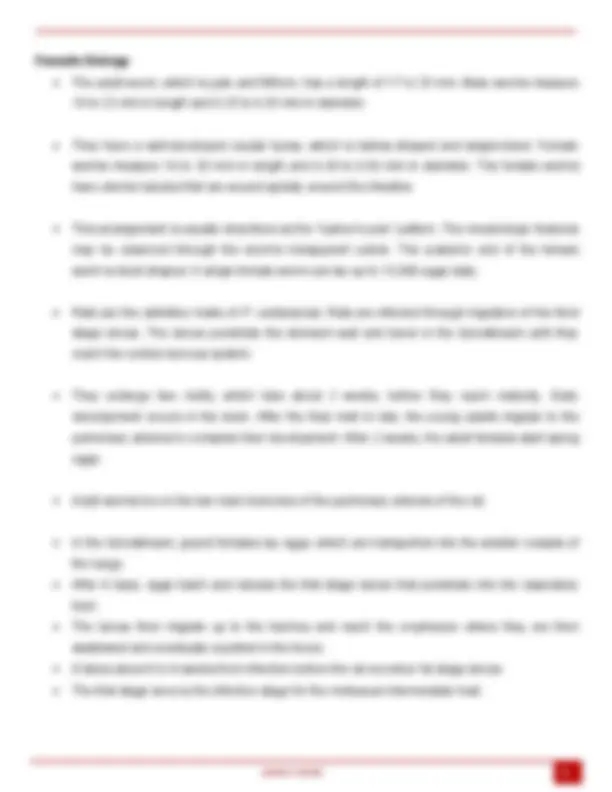
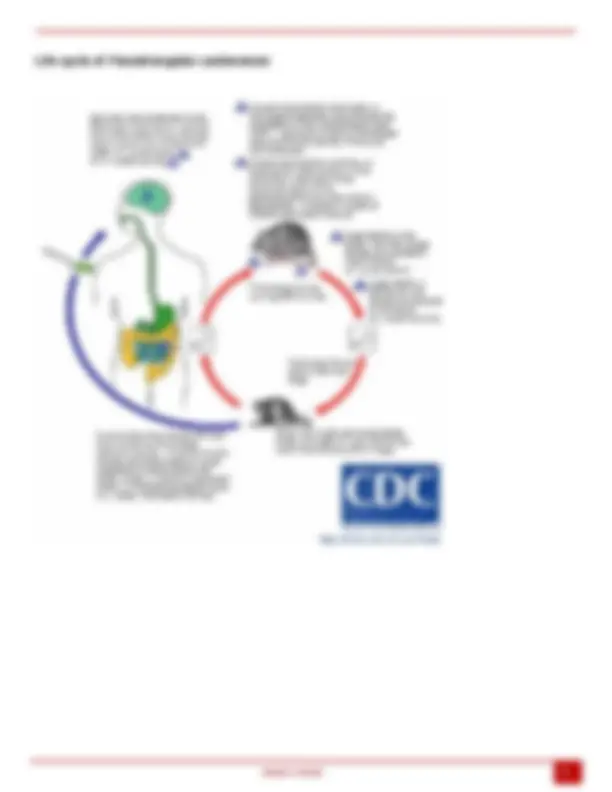
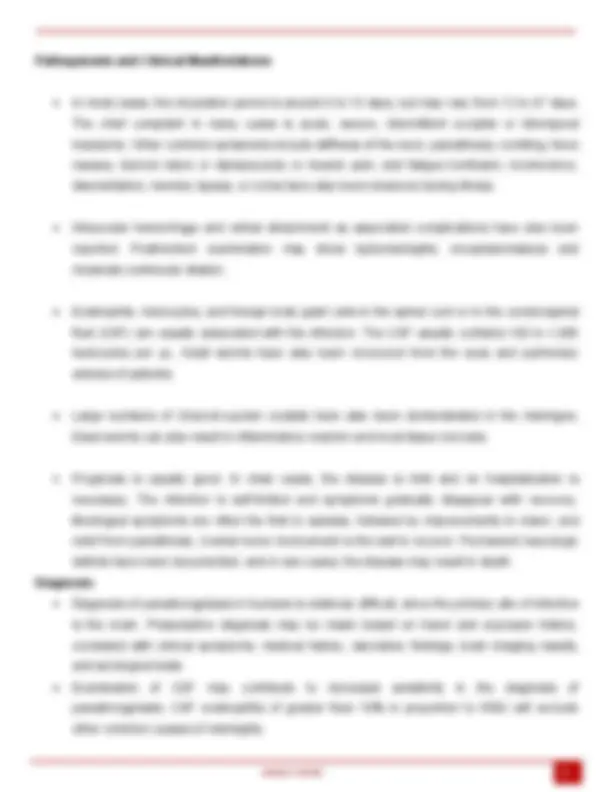
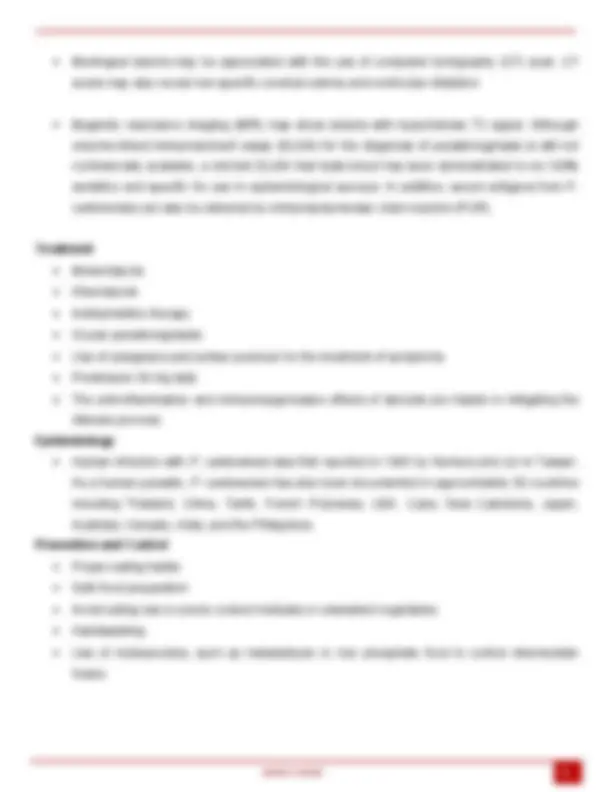
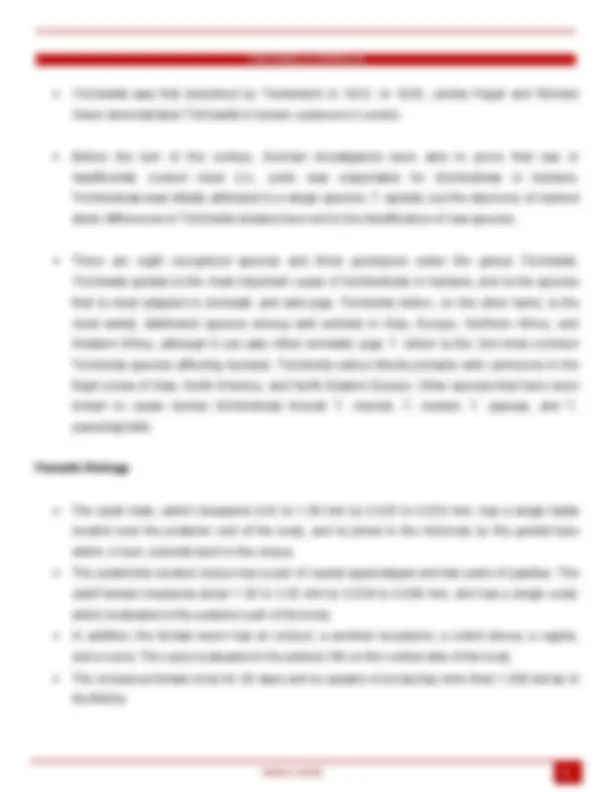
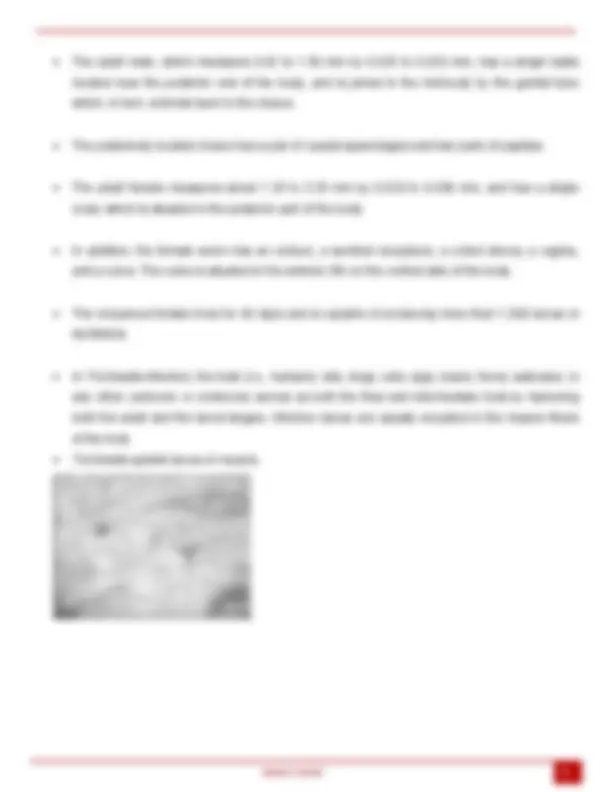
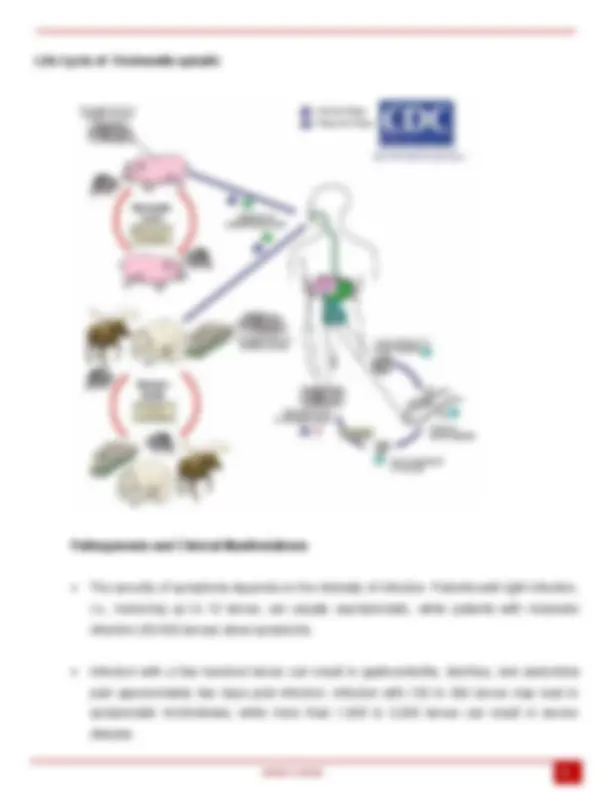
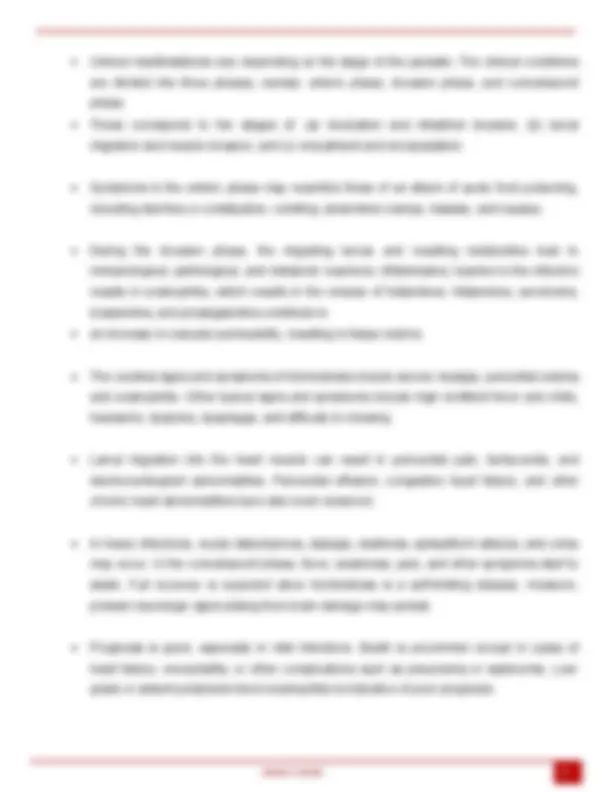
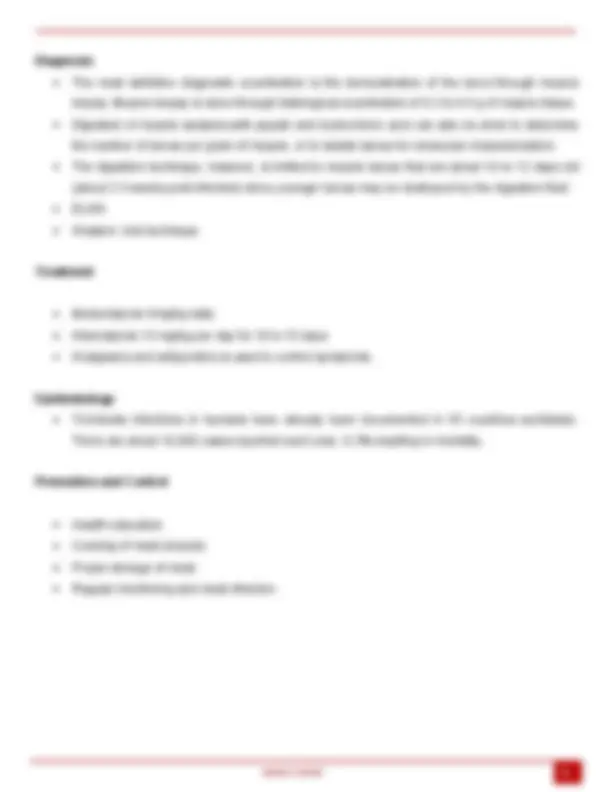
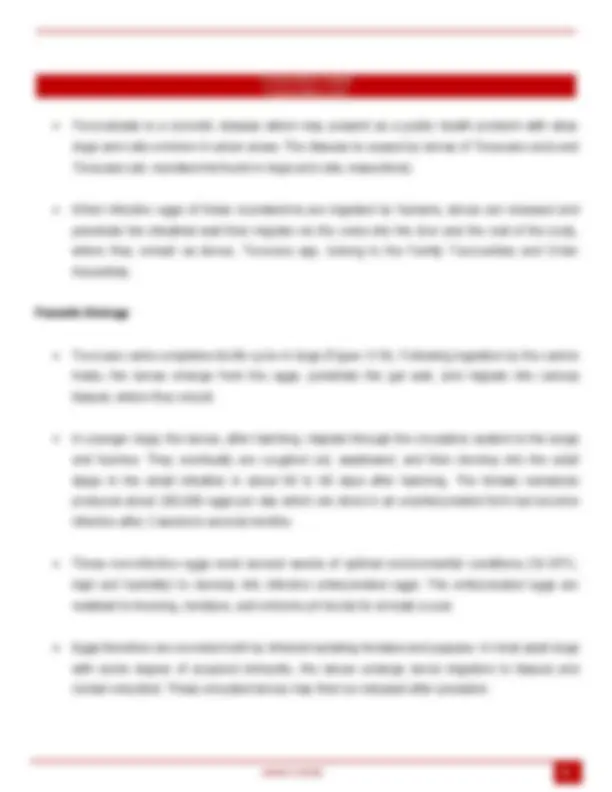
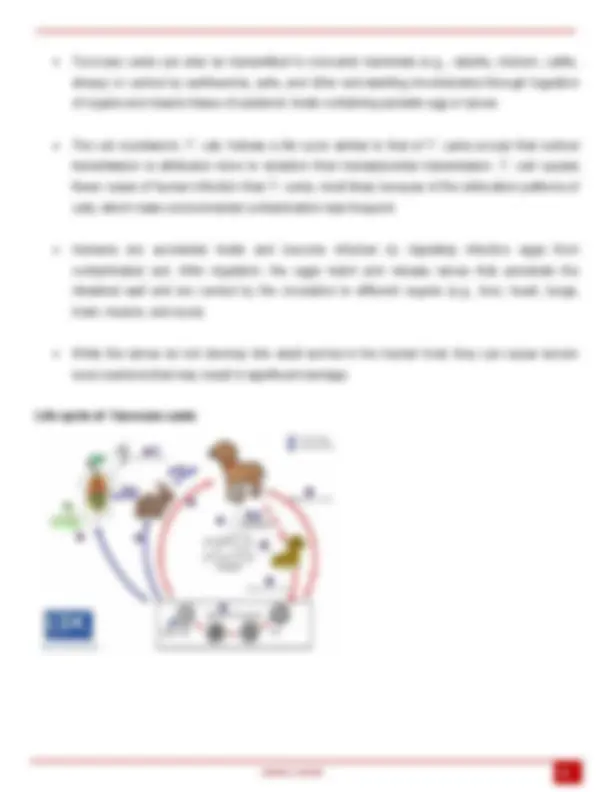
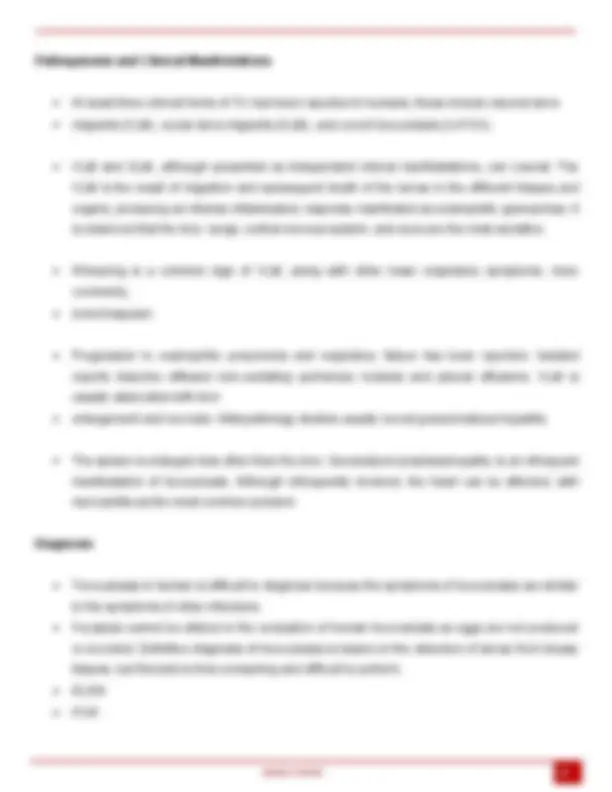


Study with the several resources on Docsity

Earn points by helping other students or get them with a premium plan


Prepare for your exams
Study with the several resources on Docsity

Earn points to download
Earn points by helping other students or get them with a premium plan
Community
Ask the community for help and clear up your study doubts
Discover the best universities in your country according to Docsity users
Free resources
Download our free guides on studying techniques, anxiety management strategies, and thesis advice from Docsity tutors
Parasitology and Microbiology reviewers
Typology: Study notes
1 / 101

This page cannot be seen from the preview
Don't miss anything!





























































































ANGELA TANTEO 1 INTESTINAL AMEBAE 7 species of amebae that occur in humans:
ANGELA TANTEO 2 They vary in size from 12 to 60 μm in diameter. hyaline pseudopodium is formed when the clear, glasslike ectoplasm, or outer layer is extruded, and the granular endoplasm flows into it. Ingested red blood cells are observed as pale, greenish, refractile bodies in the cytoplasm of the ameba. Cysts are usually spherical, and the size may vary from 10 to 20 μm. They are characterized by a highly refractile hyaline cyst wall, one to four nuclei, and rod-shaped (or cigar- shaped) chromatoidal bars. Trophozoites have the ability to colonize and/or invade the large bowel, while cysts are never found within invaded tissues. E. histolytica trophozoites multiply by binary fission. They encyst producing uninucleate cysts, which then undergo two successive nuclear divisions to form the characteristic quadrinucleate cysts. E. histolytica is a eukaryotic organism but has several unusual features, including the lack of organelles that morphologically resemble mitochondria. Proposed mechanisms for virulence are: production of enzymes or other cytotoxic substances, contact-dependent cell killing, and cytophagocytosis. In vitro, amebic killing of target cultivated mammalian cells involve receptor-mediated adherence of ameba to target cells, amebic cytolysis of target cells, and amebic phagocytosis of killed or viable target cells. E. histolytica trophozoites adhere to the colonic mucosa through a galactose-inhibitable adherence lectin (Gal lectin). Then, the amebae kill mucosal cells by activation of their caspase-3, leading to their apoptotic death engulfment. Amebic colitis clinically presents as gradual onset of abdominal pain and diarrhea with or without blood and mucus in the stools. Fever is not common and it occurs only in one third of patients. Although some patients may only have intermittent diarrhea alternating with constipation, children may develop fulminant colitis with severe bloody diarrhea, fever, and abdominal pain. Onset of amebic colitis may be sudden after an incubation period of 8 to 10 days, or after a long period of asymptomatic cyst carrier state. Most serious complication of amebic colitis is perforation and secondary bacterial peritonitis. Acute amebic colitis should be differentiated from bacillary dysentery of the following etiology: Shigella, Salmonella, Campylobacter, Yersinia, and enteroinvasive Escherichia coli.
ANGELA TANTEO 4 furoate is the drug of choice for asymptomatic cyst passers. It is also given after a course of metronidazole for invasive amebiasis Humans are the major reservoirs of infection with E. histolytica. Ingestion of food and drink contaminated with E. histolytica cysts from human feces, and direct fecal-oral contact are the most common means of infection. Amebic infection is prevalent in the Indian subcontinent, Africa, East Asia, and South and Central America. Proper use of latrines and practice of proper hygiene, such as washing of hands, should be emphasized. In communities where potable water is not available, drinking water should be boiled or filtered. Vegetables and fruits which are eaten raw should be thoroughly washed. The use of night soil for fertilizer should be avoided. Food handlers should be screened for cyst carriage, and asymptomatic cyst carriers should be treated. COMMENSAL AMEBAE Genus Entamoeba has a spherical nucleus with a distinct nuclear membrane lined with chromatin granules and a small karyosomefound near the center of the nucleus. Trophozoites usually have only one nucleus. The genus Endolimax has a vesicular nucleus with a relatively large, irregularly-shaped karyosome anchored to the nucleus by achromatic fibrils. The^ genus^ Iodamoeba^ is^ characterized^ by^ a large, chromatin-rich karyosome surrounded by a layer of achromatic globules and anchored to the nuclear membrane by achromatic fibrils. All species have the following stages: trophozoite, precyst, cyst, and metacystic trophozoite; with the exception of Entamoeba gingivalis, which has no cyst stage, and does not inhabit the intestines. Reproduction is by binary fission of the trophozoites. Encystation occurs as amebae pass through the lower colon where colonic contents are more dehydrated.
ANGELA TANTEO 5 ENTAMOEBA DISPAR Entamoeba dispar is morphologically similar to E. histolytica, but their DNA and ribosomal RNA are different. The former’s isoenzyme pattern is different from that of E. histolytica. ENTAMOEBA MOSHKOVSKII Although first detected in sewage, have been reported in some areas, such as North America, Italy, South Africa, Bangladesh, India, Iran, and Australia. It is a non-pathogenic species that is morphologically indistinguishable from E. histolytica and E. dispar, but differs from them biochemically and genetically. E. moshkovskii is also physiologically unique—it being osmotolerant, able to grow at room temperature (25-30°C optimum), able to survive at temperatures ranging from 0 to 41 °C. It has limited pathogenicity in experimental trials in animals, but is non-pathogenic to humans. All human isolates have been found to belong to one group “ribodeme 2.” ENTAMOEBA HARTMANNI This is smaller than E. histolytica. Trophozoites of the former measure from 3 to 12 μm in diameter (compared to E. histolytica measuring 12-60 μm). Mature cysts measure 4 to 10 μm, are quadrinucleated like E. histolytica, and have rod-shaped chromatoid material with rounded or squared ends. This specie does not ingest red cells. ENTAMOEBA COLI More common than other human amebae, trophozoites of E. coli measure 15 to 50 μm in diameter. can be differentiated from E. histolytica trophozoite by the following features: 1) a more vacuolated or granular endoplasm with bacteria and debris, but no red blood cells; 2) a narrower, less-differentiated ectoplasm; 3) broader and blunter pseudopodia used more for feeding than locomotion; 4) more sluggish, undirected movements; and 5) thicker, irregular peripheral chromatin with a large, eccentric karyosome in the nucleus. E. coli cyst may be differentiated from E. histolytica by: 1) its larger size (10 to 35 μm in diameter), 2) more nuclei (eight versus four in E. histolytica), 3) more granular cytoplasm, and 4) splinter-like chromatoidal bodies. Iodine staining reveals dark-staining, perinuclear masses, which are actually glycogen. Its location, surrounding the nucleus, is more characteristic of E. coli compared to E. histolytica. ENTAMOEBA POLECKI A parasite found in the intestines of pigs and monkeys. Rarely, it can infect humans, though a high prevalence (19%) was reported in some parts of Papua New Guinea. both pig-to-human and human-to-human transmission may exist. Like E. coli, motility of trophozoites of E. polecki is sluggish. A small karyosome is centrally located in the nucleus. E. polecki can be distinguished from E. histolytica in that the former’s cyst is consistently uninucleated, and chromatoidal bars are frequently angular or pointed. In stained fecal smears, the nuclear membrane and karyosome are very prominent. ENTAMOEBA CHATTONI Found in apes and monkeys, is morphologically identical to E. polecki. More recently, it has been detected in eight human infections. Identification of E. chattoni was done via isoenzyme analysis. ENTAMOEBA GINGIVALIS Can be found in the mouth. The trophozoite measures 10 to 20 μm. It moves quickly, and has numerous blunt pseudopodia. Food vacuoles that contain cellular debris (mostly leukocytes, which is characteristic of this species) and bacteria are numerous. Lives on the surface of gum and teeth, in gum pockets, and sometimes in the tonsillar crypts. They are abundant in cases of oral disease. This species has no cyst stage. Transmission is most probably direct: through kissing, droplet spray, or by sharing utensils. ENDOLIMAX NANA Occurs with the same frequency as Entamoeba coli. Trophozoites are small, with a diameter of 5 to 12 μm, and exhibit sluggish movement. They have blunt, hyaline pseudopodia, and the nucleus has a large, irregular karyosome. Food vacuoles found in the cytoplasm may contain bacteria. Cysts measure about the same size as trophozoites, and are quadrinucleated when mature. IODAMOEBA BÜTSCHLII Averages 9 to 14 μm in diameter (ranging from 4-20 μm). It is identified by its characteristic large, vesicular nucleus with a large, central karyosome, surrounded by achromatic granules. There are no peripheral chromatin granules on the nuclear membrane.
ANGELA TANTEO 7 keratitis. GRANULOMATOUS AMEBIC ENCEPHALITIS Acanthamoeba was documented as the causative agent of human GAE by Stamm in 1972. Amebae were demonstrated in brain sections of a GAE patient using indirect fluorescence microscopy. The acquired immune deficiency syndrome (AIDS) epidemic in the 1980 ’s dramatically increased the numbers of person with GAE, but these numbers have since fallen with the advent of highly effective antiretroviral therapy. Signs and symptoms of GAE are generally related to destruction of brain tissue and the associated meningeal irritation. Systemic manifestations early in the course include fever, malaise, and anorexia. Neurologic symptoms may include increased sleeping time, severe headache, mental status changes, epilepsy, and coma. Entry of Acanthamoeba into the central nervous system is still incompletely understood. From a primary site of infection in the skin or lungs, the likely route of invasion is hematogenous. Direct infection through the olfactory valves has also been proposed, but not conclusively demonstrated. Recent reviews have focused on blood-borne invasion, with a combination of host factors, elucidation of serine proteases, and parasite adhesion using a mannose-binding protein all contributing to brain endothelial cell damage and subsequent breakdown of the blood-brain barrier. The incubation period from initial inoculation is approximately 10 days, with a subacute and chronic clinical course of infection that lasts for several weeks to several months. DIAGNOSIS Acanthamoeba keratitis is diagnosed by epithelial biopsy or corneal scrapings for recoverable ameba with characteristic staining patterns on histologic analysis. Amebae have also been isolated from the contact lens and lens solution of patients. Species-specific identification can be made from culture and molecular analysis through PCR. Specific diagnosis depends on demonstrating the trophozoites or cysts in tissues using histopathologic stains and microscopy. The organisms can rarely be demonstrated in the cerebrospinal fluid. TREATMENT Medical treatment of AK has been met with increasing success in recent years D’Aversa and his colleagues have achieved acceptable results with clotrimazole combined with pentamidine, isethionate, and neosporin. Other agents that have been used include polyhexamethylene biguanide, propamidine, dibromopropamidine isethionate, neomycin, paromomycin, polymyxin B, ketoconazole, miconazole, and itraconazole.
ANGELA TANTEO 8 Clinically apparent neurologic disease in GAE usually heralds a fatal outcome within 3 to 40 days. A few patients have shown good responses to combinations of amphotericin B, pentamidine isethionate, sulfadiazine, flucytosine, fluconazole or itraconazole. EPIDEMIOLOGY Acanthamoeba spp. have a protean distribution, having been isolated from a multitude of natural and artificial aquatic environments including fresh and salt water, sewage, hospital equipment, and contact lenses and lens solution. PREVENTION AND CONTROL A robust immune system is able to prevent infection, except in relatively immunocompromised sites such as the cornea. Meticulous contact lens hygiene is essential in avoiding infection, and rinsing contact lenses in tap water should be avoided. Prolonged heating and boiling kill amebic trophozoites and cyst forms NAEGLERIA SPP. PARASITE BIOLOGY Free-living protozoans with two vegetative forms: an ameba (trophozoite form), and a flagellate (swimming form). A dormant cyst form is produced when conditions are not favorable. Transformation from the trophozoite to the flagellate form may facilitate more rapid movement toward food sources.
ameboid and ameboflagellate, The ameboid trophozoites measure 10 to 35 μm but when rounded are usually 10 to 15 μm in diameter. In culture, trophozoites may get over 40 μm. Naegleria spp. are thermophilic organisms which thrive best in hot springs and other warm aquatic environments. Both nonpathogenic and pathogenic forms exist. Naegleria fowleri has three stages, cysts, trophozoites, and flagellated forms, in its life cycle. The trophozoites replicate by promitosis (nuclear membrane remains intact) and can turn into temporary non-feeding flagellated forms, which usually revert back to the trophozoite stage. Trophozoites infect humans or animals by penetrating the nasal mucosa and migrating to the brain via the olfactory nerves.
Protozoan Infections CILIATES AND FLAGELLATES BALANTIDIUM COLI Initially identified as Paramecium coli by Malmsten in 1857 Balantidiasis, balantidiosis, or balantidial dysentery. It is considered as the largest protozoan parasite affecting humans and is the only ciliate known to cause human disease. It is capable of attacking the intestinal epithelium, resulting in ulcer formation which, in turn, causes bloody diarrhea similar to that of amebic dysentery. This organism is primarily associated with pigs, its normal host. PARASITE BIOLOGY Balantidium^ coli^ trophozoite^ measures^30 to^150 μm^ long^ and^25 to^120 μm^ wide. Trophozoites are covered with cilia arranged in a longitudinal pattern extending from the oral to the caudal region. o It has a cytostome, an oral apparatus at the tapered anterior end, through which it acquires food, and a cytopyge at the rounded posterior end through which it excretes waste. o It has two dissimilar nuclei. o The macronucleus is usually bean-shaped and can easily be identified in stained specimens, while the micronucleus is round and lies in the concavity of the macronucleus. B. coli has two contractile vacuoles that act as osmoregulatory organelles. The parasite also contains extrusive organelles called mucocysts which are located beneath the cell membrane. Cysts are spherical to slightly ovoid in shape and measure 40 to 60 μm in diameter. o They are covered with thick cell walls (doublewalled). o Encystation does not result in an increase in number of nuclei. Human infection results from ingestion of food and/or water contaminated with B. coli cysts. The incubation period is normally from 4 to 5 days. Ingested cysts excyst in the small intestines and become trophozoites. Trophozoites inhabit the lumen, mucosa, and submucosa of the large intestines, primarily the cecal region causing pathologic changes in the colonic wall and mucosa. Reproduce asexually through asymmetric binary fission, although sexual reproduction through conjugation has been reported.
Protozoan Infections Cysts are formed principally as protection for survival outside the host. The parasites encyst during intestinal transport or after evacuation of semi-formed stools. Cysts are the infective stage, and they may remain viable for several weeks PATHOGENESIS AND CLINICAL MANIFESTATIONS Balantidium coli trophozoites are capable of attacking the intestinal epithelium and creating a characteristic ulcer with a rounded base and wide neck, in contrast to the flask-shaped, narrow necked ulcers of amebiasis. Ulceration is caused by the lytic enzyme hyaluronidase which is secreted by the trophozoite. The trophozoites are abundant in exudates on mucosal surfaces; while inflammatory cells and trophozoites are numerous in the base of the ulcers. Trophozoites also invade the submucosa and the muscular coat, including blood vessels and lymphatics. Intrinsic host factors including nutritional status, intestinal bacteria flora, achlorhydria, alcoholism, and presence of chronic disease contribute to host susceptibility to and severity of B. coli infection. Co-infection with other organisms may also contribute to severity of B. coli infection. The presence of Salmonella in the intestines has been shown to aggravate balantidiasis by invading the ulcers caused by the protozoan. Balantidiasis has three forms of clinical manifestations. Asymptomatic carriers are those who do not present with diarrhea or dysentery, but may serve as parasite reservoir in the community. Fulminant balantidiasis, or balantidial dysentery involves diarrhea with bloody and mucoid stools, which is sometimes indistinguishable from amebic dysentery. Acute cases may have 6 to 15 episodes of diarrhea per day accompanied by abdominal pain, nausea, and vomiting. This form of balantidiasis is often associated with immunocompromised and malnourished states. The third form of balantidiasis is the chronic form wherein diarrhea may alternate with constipation, and may be accompanied by nonspecific symptoms such as abdominal pain or cramping, anemia, and cachexia.
Protozoan Infections Currently there are no reports of B. coli exhibiting drug resistance. EPIDEMIOLOGY The distribution of B. coli is cosmopolitan and is more prevalent in areas with poor sanitation, close contact with pigs or pig feces (e.g., farms, abattoirs), and in overcrowded institutions (e.g., asylum, orphanages, prisons). Warm and humid climates in tropical and subtropical countries can also contribute to the survival of cysts. High prevalence levels in pigs have been reported in regions in Latin America and the Middle East, as well as in the Philippines, Papua New Guinea, and the West Irian province of Indonesia. There is an estimated 1% worldwide prevalence of human B. coli infection. Pigs are the major host of balantidiasis, although primates have been reported to harbor infection. In a study done in two (northern and southern) sites in the Philippines, an examination of pigs revealed 66.1% prevalence of B. coli infection. PREVENTION AND CONTROL Proper sanitation, safe water supply, good personal hygiene, and protection of food from contamination. Measures to limit contact of pigs with water sources and food crops may also contribute to reducing transmission and infection. Use of pig feces as fertilizer should also be avoided. Though cysts may be resistant to environmental conditions and may survive for long periods of time, they are easily inactivated by heat and by 1% sodium hypochlorite. Ordinary chlorination of water is not effective against B. coli cysts
Protozoan Infections GIARDIA DUODENALIS Intestinal parasitic flagellate of worldwide distribution. It is known to cause epidemic and endemic diarrhea. Also known as Giardia intestinalis or G. lamblia. It was first discovered in 1681 by Antoine van Leeuwenhoek in his own stools and was first described by Lambl in 1859 who called it Cercomonas intestinalis, later renamed Giardia lamblia by Stiles in 1915. Giardiasis, manifests as a significant but not life-threatening gastrointestinal disease. PARASITE BIOLOGY Giardia duodenalis is a flagellate that lives in the duodenum, jejunum, and upper ileum of humans. It has a simple asexual life cycle that includes trophozoites and quadrinucleated infective cyst stages. Molecular typing of isolates shows that those which parasitize humans can be classified as belonging to either assemblage A or B genotypes based on specific sequences in the small subunit of their ribosomal RNA. The^ trophozoites^ measure^9 to^12 μm^ long^ by^5 to^ l5^ μm^ wide. They are pyriform or teardrop shaped, pointed posteriorly, with a pair of ovoidal nuclei, one on each side of the midline. The dorsal side of the organism is convex, while the ventral side is concave with a large adhesive disc used for attachment. It is bilaterally symmetrical, with a distinct medial line called the axostyle.
Protozoan Infections Attachment was observed to be maximal at body temperature and stable at a pH of 7.8 to 8.2. The parasite may also produce a lectin which, when activated by duodenal secretions, is able to facilitate attachment. Once attached, the organism is able to avoid peristalsis by trapping itself in between the villi or within the intestinal mucus. Upon attachment to the intestinal cells, G. duodenalis is able to cause alterations in the villi such as villous flattening and crypt hypertrophy. These alterations lead to decreased electrolyte, glucose, and fluid absorption, and cause deficiencies in disaccharidases. Studies on Giardia muris-infected mice showed diffuse loss of microvillous surface area which investigators also correlated to decreased maltase and sucrase activities. The physiologic disturbances subsequently result in malabsorption and maldigestion, which in turn cause the signs and symptoms experienced by the patient. Bacterial colonization of the area may further worsen the damage already caused by the parasite. In other studies, G. duodenalis was shown to rearrange the cytoskeleton in human colonic and duodenal monolayers. Cytoskeleton is essential for proper cell attachment to the extracellular matrix and the other neighboring cells. Changes observed in apoptotic cells include disruption of the cytoskeleton that leads to structural disintegration and detachment from the substrate. Hence, the parasite has been suggested to cause enterocyte apoptosis. From ingestion of the cysts, it takes about 1 to 4 weeks (average of 9 days) for the disease to manifest. Half of the infected patients may be asymptomatic. For acute cases, patients experience abdominal pain, described as cramping, associated with diarrhea. There is also excessive flatus with an odor of “rotten eggs” due to hydrogen sulfide. Other clinical features include abdominal bloating, nausea, and anorexia. Diarrhea is the most common symptom, occurring in 89% of cases. It is followed by malaise and flatulence. Spontaneous recovery occurs within 6 weeks in mild to moderate cases.
Protozoan Infections In untreated cases, patients may experience diarrhea with varying intensities, for weeks or months. Chronic infection is characterized by steatorrhea, or the passage of greasy, frothy stools. There may be weight loss, profound malaise, and low-grade fever. In developing countries, it has been described as a cause of the failure-to-thrive syndrome. DIAGNOSIS Diagnosis is made by demonstration of G. duodenalis trophozoites (Plate 2.11) and/or cysts (Plate 2.12) in stool specimens. Trophozoites in direct fecal smears may be characterized as having a floating leaf-like motility. To detect cysts in stools, concentration techniques are recommended. At least three stool examinations on alternate days are recommended because of spotty shedding of cysts. If the parasite is not found in the feces, duodeno-jejunal aspiration may be done. Examination of the duodenal contents for trophozoites gives a higher percentage of positive findings compared to examination of feces. In a patient with chronic diarrhea, giardiasis should be considered as a possible cause. Aside from duodenal aspiration, the Enterotest® (HDC Mountain View, CA) may demonstrate Giardia trophozoites. The patient swallows a gelatin capsule attached to a nylon string, with one end of the string attached to the patient’s cheek. After about 4 to 6 hours, the string is removed, and any adherent fluid is placed on the slide for microscopic examination. Presently, antigen detection tests and immunofluorescent tests are already available as commercial kits. Immunochromatographic assays detect the presence of Giardia antigen in stool. Cyst wall protein 1 (CWP1) is one of the antigens used for these diagnostic tests. Direct fluorescent antibody assays have been considered by many laboratories as the gold standard in diagnosis as such assays have the highest combination of sensitivity and specificity.
Protozoan Infections The first published study on Giardia genotypes in the Philippines showed that the majority (86%) of the isolated genotypes belong to assemblage B. Direct oral-anal sexual contact among men who have sex with men may increase the risk of giardiasis and infection with other intestinal protozoans. Outbreaks of giardiasis are more frequently reported outside the Philippines. Most of these are water-borne (recreational water or drinking water). Foodborne outbreaks have also been reported. The low infective dose, prolonged communicability, and relative resistance to chlorine facilitate the transmission of Giardia through drinking and recreational water, food, and person-to-person contact. PREVENTION AND CONTROL Methods of prevention and control include proper or sanitary disposal of human excreta to prevent contamination of food and water supply. The former can be contaminated by the use of night soil as fertilizer, by flies, or by infected food handlers. Normal water chlorination will not affect cysts, but usual water treatment modalities
Protozoan Infections should be adequate. TRICHOMONAS VAGINALIS Causes a sexually transmitted disease called trichomoniasis which has a worldwide distribution. Its incidence correlates strongly with the number of sexual partners. It was first observed by Donne in 1836 in purulent secretions of male and female urogenital tracts. It is now often described as the most prevalent non-viral sexually transmitted infection. PARASITE BIOLOGY Trichomonas vaginalis exists only in the trophozoite stage. It has a pyriform shape, measuring 7 to 23 μm with four free anterior flagella that appear to arise from a simple stalk, and a fifth flagellum embedded in the undulating membrane. This membrane extends to about half the organism’s length. The parasite has a median axostyle and a single nucleus. The parasite is found in the urogenital tract. In women, it is found in the vagina but may ascend as far as the renal pelvis. The^ parasite^ can^ be^ isolated^ from^ the^ urethra,^ prostate,^ and^ less^ frequently,^ in^ the^ epididymis^ in men. The trophozoites multiply by binary fission in the host and are transferred passively from person to person (Figure 2.7). The usual mode of transmission is by sexual intercourse.